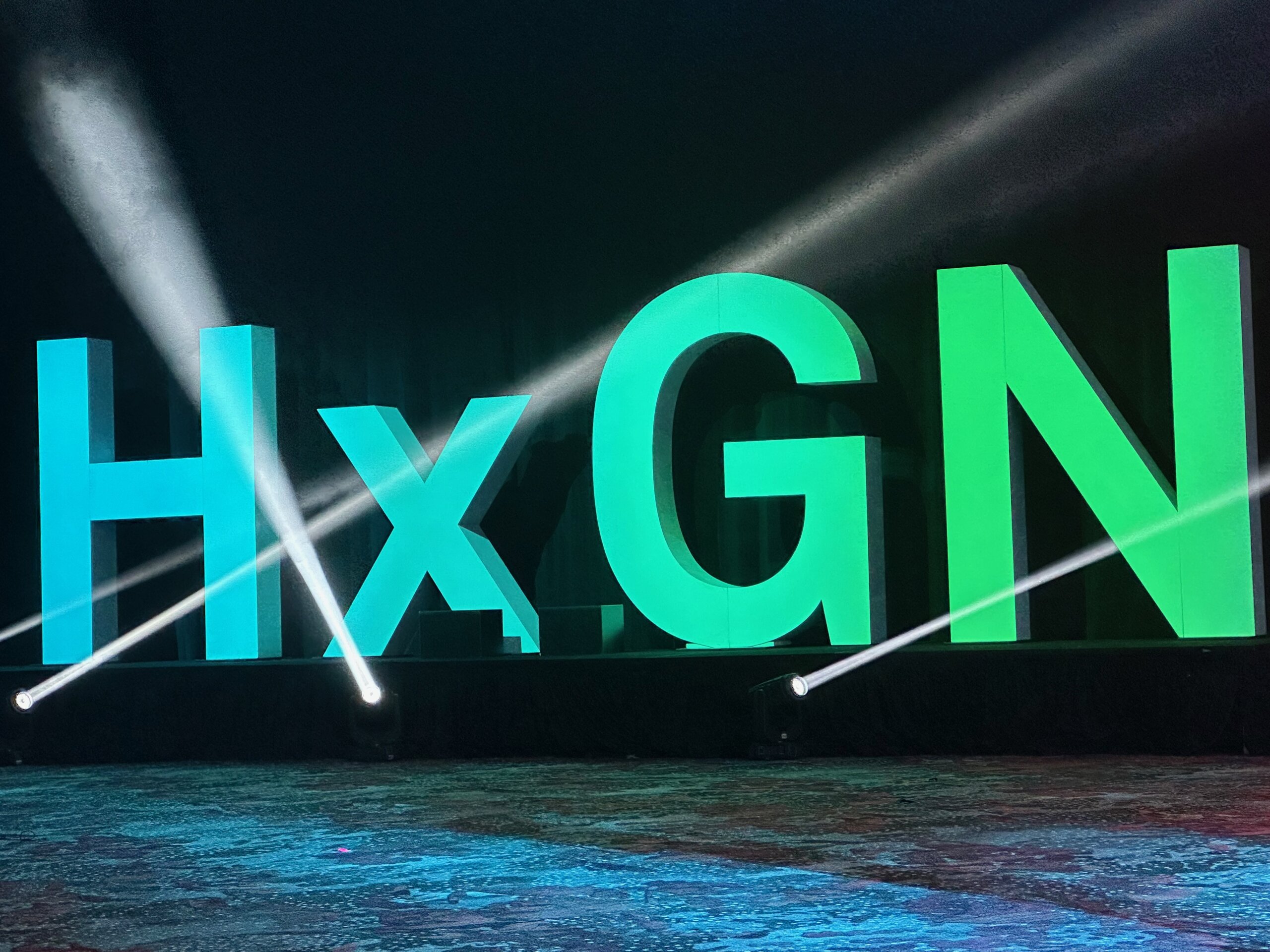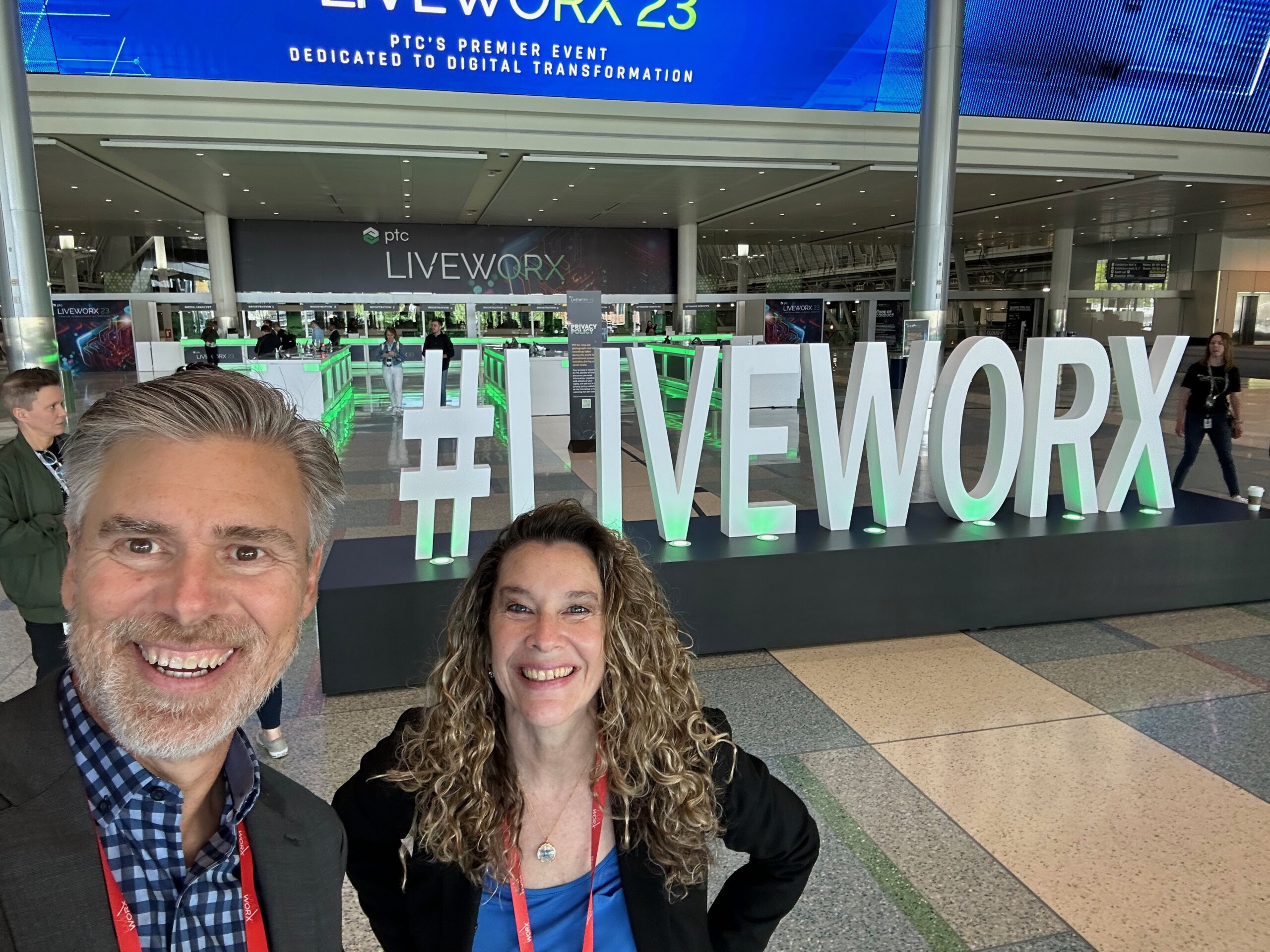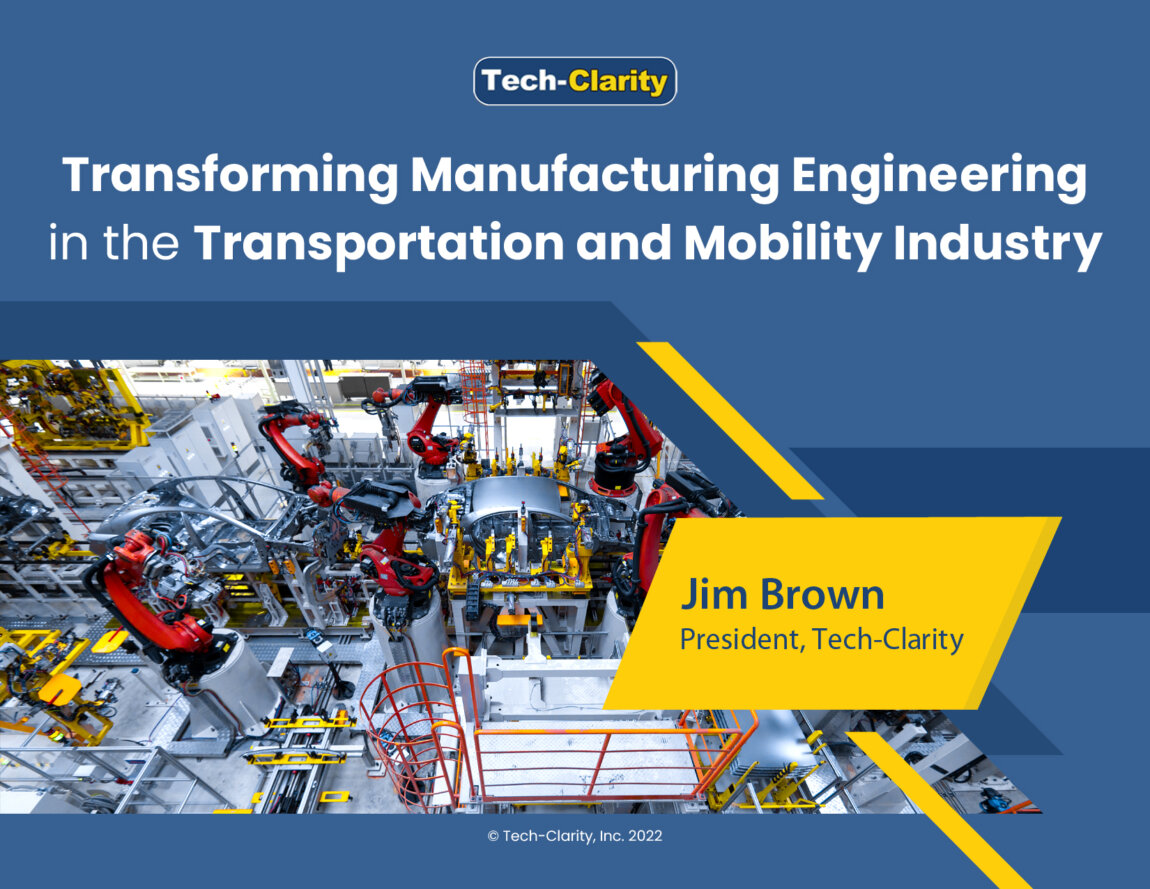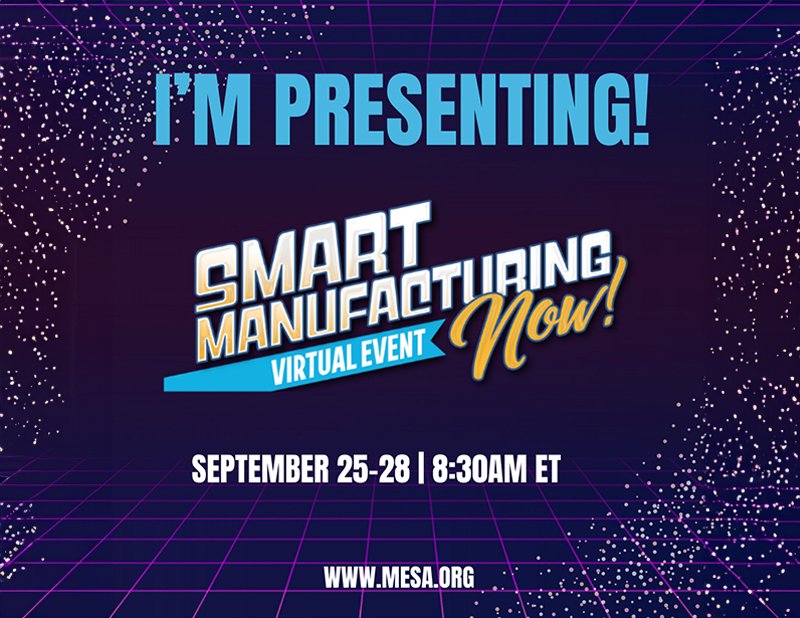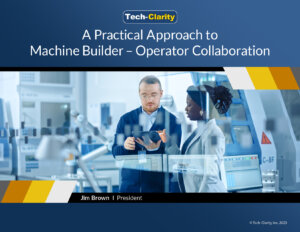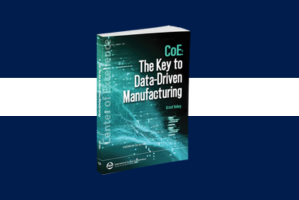How do companies prioritize the business strategies that drive their long-term success? What’s driving their strategy as they face constantly shifting global market disruptions? How do they balance initiatives like digital transformation, ESG, developing their workforce, and adopting new business models to ensure business sustainability in 2023 and beyond? Read our 5th annual survey to…
- Disruptions Vary, But Risk is Constant
- Preparing for Success
- Strategy and Initiative Drivers Have Shifted
- ESG Pressure Comes from Many Angles
- Holistic Business Sustainability
- Putting Strategy into Action
- Technology is Key to Business Sustainability
- Technology Drivers Significant Business Benefits
- Conclusions and Recommendations
- About the Research
- Acknowledgments
A Time to Create Agility and Improve Sustainability
No Major Shocks, But Risk Remains The past decade confronted businesses with a constant barrage of disruptions, including natural catastrophes and human-created disasters. Although the business environment is still turbulent, industry faced fewer significant new events since our survey in 2022. Our fifth annual survey, though, shows that risks remain. Although the percentage saying business risk and disruption has increased "significantly" dropped 27% from the prior year, about three-quarters of responding companies still say it has grown over the last five years. Despite the lack of new shocks, companies in 2023 report that they still struggle with supply chain challenges, the fallout of COVID, and the impact of armed conflict. They also face lingering economic uncertainty despite relaxing global recession fears. Moreover, while it's not new, the threat from climate change is coming to fruition, and predicted impacts appear to be ahead of schedule. In 2022, the world's oceans were the hottest in history and exceeded the 2021 recorded maximum, and experts warn that "this year's United in Science report shows climate impacts heading into uncharted territory of destruction." Events like Canada's 2023 wildfires are constant reminders of climate change impacts and are becoming more common. Time to Continue Transformation and Drive Sustainability Our surveys on long-term business success show that companies responded to prior disruptions by accelerating technology adoption to increase agility and become more resilient. Now is the time for companies to continue with digital transformation to prepare for future inevitable disruptions and continuously improve efficiency in the face of continued economic uncertainty. At the same time, they must act on sustainability initiatives that are becoming critical to both human experience and continued economic success. Given the landscape, how are companies prioritizing the essential pillars of long-term business sustainability to ensure business success in 2023 and beyond?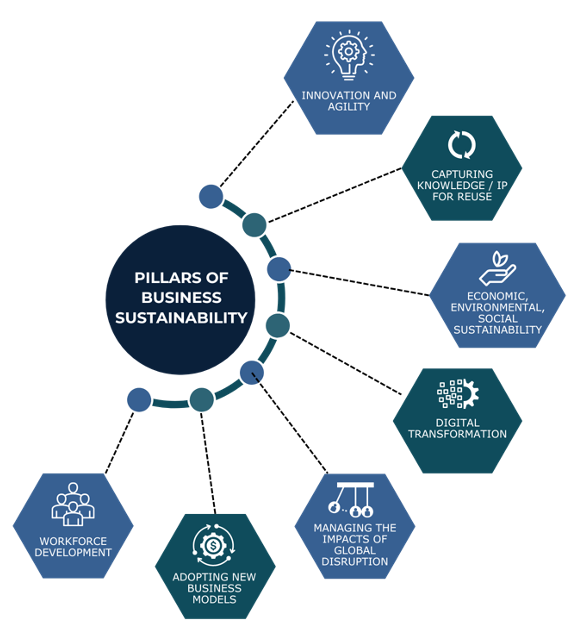
Strategy and Initiative Drivers Have Shifted
A Period of (Relative) Stability Responding to global disruption dropped as a strategy driver from 52% of companies in 2020 to 10% in 2023, the lowest point since COVID began impacting global markets (see next page). This is a strong indicator that disruption may have eased off, at least so far this year. Instead, companies appear to be back on track with ambitious strategies for business sustainability. Long-term growth goals are about the same and remain the most common strategy driver. Growth goals have been a constant from the beginning of this research series, and now financial market perception has grown from a low of 20% in 2020 to one-half of companies this year. ESG becomes a Larger Factor Other factors that influence corporate strategy and initiatives have shifted. Respondents now report that strategic plans are more driven by financial market perception and ESG factors. This is very different from the "survival mode" companies faced in 2020, where essential initiatives like environmental sustainability were pushed to the side. In fact, almost one-half of respondents report that government regulation drives their strategy this year, growing by 48% since 2019. We expect that these regulations are largely focused on greenhouse gas emissions and other environmental mandates. Other ESG business pressures are becoming more prevalent as well. Environmental issues were reported 83% more frequently as a strategy driver than in 2019 and have continued to climb since a low in 2020. In addition, 44% report corporate responsibility drives strategy, growing 63% since 2019, reflecting an additional ESG-related factor being considered more frequently in strategy decisions. New Focus on New Energy This year, we began tracking how the transition to new energy drives strategy and found that over one-third report it as a driver. We believe government regulation will add to existing transformation pressures such as cost and scarcity and spur more direct activity in this area. At the same time, government investment in new energy initiatives will also likely influence corporate direction. These drivers will further ESG efforts both directly and indirectly.
Technology is Key to Business Sustainability
Technology Critical to Business Success and Profitability The second factor we investigated in detail is technology. Technology plays a crucial role in supporting the pillars and driving long-term success and profitability. To demonstrate this, a full 87% percent share that technology is important to business success, and 30% say it's critical. Technology plays a crucial role in supporting each of the pillars of long-term success. About three-quarters of companies share that technology is critical or important to five of the seven pillars, and about two-thirds report it's important to the others. Reaching ESG Goals Demands Technical Support Perhaps one of the more surprising findings is technology's high importance in supporting ESG. Companies now recognize that they need to take a systematic approach to environmental sustainability. Making sustainable decisions and green reporting require a tremendous amount of data from across the business and the supply chain. Technology is vital to capturing information and reporting on sustainability, but also to developing the insights needed to improve it. ESG technology is full of innovation. From our experience, companies are not finding a single application for ESG. They are applying existing technologies to make more sustainable choices in everything from product and service innovation to business execution. Technology is Crucial to Transformation Technology is also seen as most important to digital transformation and product / service innovation and agility. Each of these is reported as "critical" by one-third of companies. The speed and scope of innovation demand a broad array of information and collaboration across disciplines. Technology Supports Business Sustainability Technology adoption continues to play a role in preparing for and responding to disruption, providing companies the agility they need to identify and react to issues. Technology alone doesn't achieve these goals, but the key finding is that modern businesses can't survive into the future without adopting technology to support them in the digital age.Conclusions and Recommendations
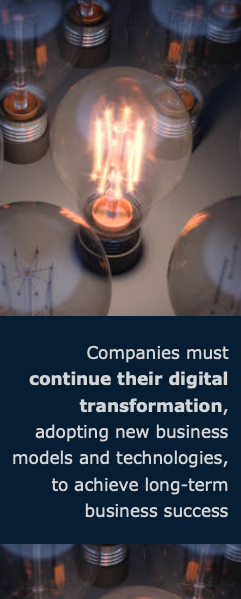 Disruption is Lower, but Remain Vigilant
Risk and disruption continue to grow, but significant disruption may have leveled off (for now). Although the most common disruptions today are the supply chain and financial market, our research shows that the problems companies face vary. Businesses should anticipate ongoing disruption and the need to develop agility and resilience. Global business means companies are constantly at risk, it's simply the reality.
Take the Long View
It's essential to prepare for disruption but stay focused on long-term business needs. Company success drivers are optimistic and show a belief in the long view, including long-term profits, innovation, and transformation. Disruptions come and go. As companies mitigate risk by becoming ever more agile and responsive, they must also stay focused on the enduring fundamentals of business success, such as customer relationships and long-term profits, while digitally transforming to stay relevant for the long term. At the same time, they must also attract and develop the workforce of the future.
Stay Focused on Sustainability
Companies are taking a balanced approach and continue to focus across the pillars of business sustainability. But the world has changed, and strategic drivers have shifted to put more emphasis on financial markets and the environment. One of the most significant increases in attention is ESG. Environmental and social responsibility are becoming increasingly critical to long-term business success. Companies must continue to drive their internal green initiatives while satisfying regulatory demands. Fortunately, regulations are beginning to reflect environmental imperatives and create a level playing field that supports both business and the environment.
Adopt Technology to Drive Long-Term Success
Our research clearly shows that technology plays a crucial role in driving long-term company profitability and sustainability and achieving value across the pillars of business sustainability. It also delivers significant business value. Companies must continue their digital transformation, adopting new business models and technologies, to achieve long-term business success.
*This summary is an abbreviated version of the research and does not contain the full content. For the full research, please visit our sponsor Dassault Systèmes (registration required).
If you have difficulty obtaining a copy of the report, please contact us.
[post_title] => Business Strategies for Long-Term Success
[post_excerpt] =>
[post_status] => publish
[comment_status] => open
[ping_status] => open
[post_password] =>
[post_name] => business-strategies-2023
[to_ping] =>
[pinged] =>
[post_modified] => 2024-12-18 17:11:55
[post_modified_gmt] => 2024-12-18 22:11:55
[post_content_filtered] =>
[post_parent] => 0
[guid] => https://tech-clarity.com/?p=18656
[menu_order] => 0
[post_type] => post
[post_mime_type] =>
[comment_count] => 0
[filter] => raw
)
[1] => WP_Post Object
(
[ID] => 18640
[post_author] => 2
[post_date] => 2023-09-19 09:00:24
[post_date_gmt] => 2023-09-19 13:00:24
[post_content] =>
Disruption is Lower, but Remain Vigilant
Risk and disruption continue to grow, but significant disruption may have leveled off (for now). Although the most common disruptions today are the supply chain and financial market, our research shows that the problems companies face vary. Businesses should anticipate ongoing disruption and the need to develop agility and resilience. Global business means companies are constantly at risk, it's simply the reality.
Take the Long View
It's essential to prepare for disruption but stay focused on long-term business needs. Company success drivers are optimistic and show a belief in the long view, including long-term profits, innovation, and transformation. Disruptions come and go. As companies mitigate risk by becoming ever more agile and responsive, they must also stay focused on the enduring fundamentals of business success, such as customer relationships and long-term profits, while digitally transforming to stay relevant for the long term. At the same time, they must also attract and develop the workforce of the future.
Stay Focused on Sustainability
Companies are taking a balanced approach and continue to focus across the pillars of business sustainability. But the world has changed, and strategic drivers have shifted to put more emphasis on financial markets and the environment. One of the most significant increases in attention is ESG. Environmental and social responsibility are becoming increasingly critical to long-term business success. Companies must continue to drive their internal green initiatives while satisfying regulatory demands. Fortunately, regulations are beginning to reflect environmental imperatives and create a level playing field that supports both business and the environment.
Adopt Technology to Drive Long-Term Success
Our research clearly shows that technology plays a crucial role in driving long-term company profitability and sustainability and achieving value across the pillars of business sustainability. It also delivers significant business value. Companies must continue their digital transformation, adopting new business models and technologies, to achieve long-term business success.
*This summary is an abbreviated version of the research and does not contain the full content. For the full research, please visit our sponsor Dassault Systèmes (registration required).
If you have difficulty obtaining a copy of the report, please contact us.
[post_title] => Business Strategies for Long-Term Success
[post_excerpt] =>
[post_status] => publish
[comment_status] => open
[ping_status] => open
[post_password] =>
[post_name] => business-strategies-2023
[to_ping] =>
[pinged] =>
[post_modified] => 2024-12-18 17:11:55
[post_modified_gmt] => 2024-12-18 22:11:55
[post_content_filtered] =>
[post_parent] => 0
[guid] => https://tech-clarity.com/?p=18656
[menu_order] => 0
[post_type] => post
[post_mime_type] =>
[comment_count] => 0
[filter] => raw
)
[1] => WP_Post Object
(
[ID] => 18640
[post_author] => 2
[post_date] => 2023-09-19 09:00:24
[post_date_gmt] => 2023-09-19 13:00:24
[post_content] => 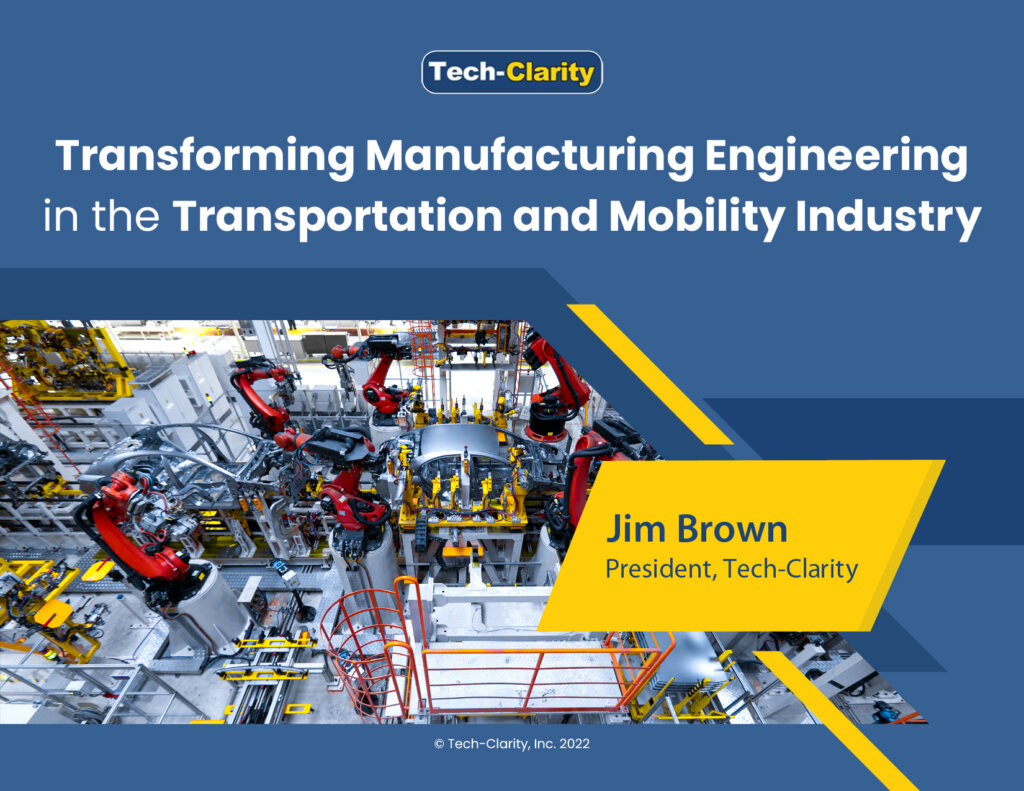 How can auto manufacturers improve process design performance in the face of increased complexity? We surveyed over 150 people involved with manufacturing engineering and found that modernizing processes and technology drives higher automotive manufacturing engineering productivity and performance. These improvements are crucial to profitability in the transportation and mobility industry as customers demand high quality, more personalized products at increasingly faster time to market; all despite rising product and manufacturing complexity.
Please enjoy the summary* below. For the full research, please visit our sponsor Dassault Systèmes DELMIA (registration required).
For related research, please read our Transforming Manufacturing in the Transportation Industry eBook.
How can auto manufacturers improve process design performance in the face of increased complexity? We surveyed over 150 people involved with manufacturing engineering and found that modernizing processes and technology drives higher automotive manufacturing engineering productivity and performance. These improvements are crucial to profitability in the transportation and mobility industry as customers demand high quality, more personalized products at increasingly faster time to market; all despite rising product and manufacturing complexity.
Please enjoy the summary* below. For the full research, please visit our sponsor Dassault Systèmes DELMIA (registration required).
For related research, please read our Transforming Manufacturing in the Transportation Industry eBook.
Table of Contents
- Improve Manufacturing Engineering to Increase Profitability
- Address Process Designer Challenges
- Recognize the Opportunity
- Quantify the Potential
- Identify Performance Drivers
- Find Issues Earlier in Design
- Use more 3D and Simulation
- Use More Advanced Ways to Support 3D / Simulation
- Leverage More Integrated Solutions
- Use More Advanced Communication and Collaboration
- Top Performers Show the Way
- Recommendations and Next Steps
- About the Research
- Acknowledgments
Improve Manufacturing Engineering Performance
Improve Performance in the Face of Complexity How can manufacturers improve manufacturing engineering? We surveyed 177 people directly involved with manufacturing engineering and found that modernizing processes and technology drives higher manufacturing engineering productivity and performance. These improvements are crucial to profitability in the transportation and mobility industry as customers demand high quality, more personalized products at increasingly faster time to market; all despite rising product and manufacturing complexity. Modernize Manufacturing Engineering Survey results show that Top Performers in manufacturing engineering have increased maturity in the way they plan, validate, and communicate manufacturing operations. These leading companies waste less time on non-value-added activities, find issues sooner, and spend less on physical prototypes. They accomplish this through best practices, including:- More advanced collaboration and communication methods
- Increased use of 3D and simulation to plan and validate manufacturing operations with virtual, digital twins
Improve Manufacturing Engineering to Increase Profitability
Product Profitability Relies on Speed, Cost, and Quality Developing profitable products in today’s transportation and mobility industry is challenging. Manufacturers have to move quickly to out-innovate their competitors without sacrificing product cost and quality. Our research1 shows that achieving product development success relies on meeting a combination of targets. According to this prior survey, the top business success and profitability drivers include faster product development, lower product cost, and increased product quality. Each of these goals is challenging, and transportation and mobility companies need to meet them simultaneously. Manufacturing Engineering’s Contribution With that in mind, we investigated the role manufacturing planning plays in achieving these product development goals. Respondents indicate that efficiency, quality, and cost most drive product success and profitability. The two most commonly reported items, manufacturing engineering efficiency and first time quality, are valuable on their own. But it’s important to recognize that both impact the time it takes a product to reach the market. The third most commonly reported factor, manufacturing cost, directly impacts product profitability. These make improving manufacturing engineering efficiency and performance strategic.Address Process Design Challenges
Manufacturing Engineers Face Increased Complexity Manufacturing is more complex than ever. Complexity has increased in three areas; products, manufacturing processes, and markets. Today’s products are going through a dramatic transformation to electrification. The shift from internal combustion engines to electric drivetrains adds complexity and demands significant changes to design and manufacturing processes. Today’s production environment may include new processes such as battery cell production or industrial additive manufacturing. Finally, transportation and mobility supply chains are shifting production and reshoring as the industry is trying to cope with supply disruption. Despite these, manufacturing engineers need to decrease cycle times and improve quality.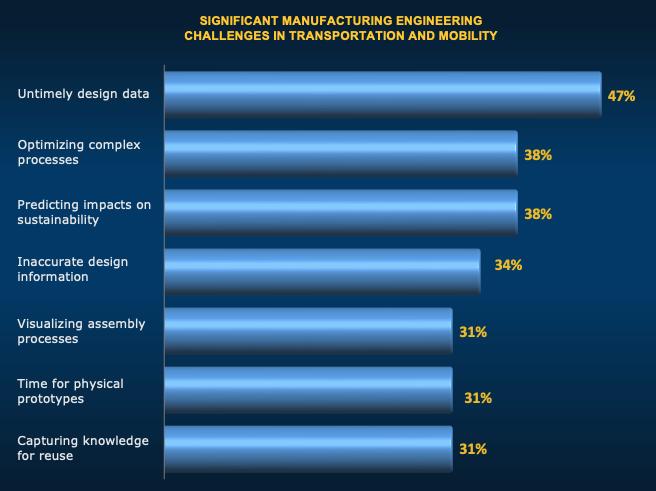 Challenges Reflect Lack of Information and Ability to Optimize
Manufacturing engineers must overcome significant challenges to design and validate production processes. The most commonly reported challenge is untimely product design data. This hampers accurate, timely process design because planners can’t access trusted product details in time to optimize production plans and provide feedback on manufacturability. They also share challenges optimizing complex processes, which is likely becoming more complicated due to vehicle electrification.
In addition, respondents report challenges predicting the impact of their decisions on sustainability, inaccurate design information, visualizing assembly processes, and the time required to build prototypes.
Challenges Reflect Lack of Information and Ability to Optimize
Manufacturing engineers must overcome significant challenges to design and validate production processes. The most commonly reported challenge is untimely product design data. This hampers accurate, timely process design because planners can’t access trusted product details in time to optimize production plans and provide feedback on manufacturability. They also share challenges optimizing complex processes, which is likely becoming more complicated due to vehicle electrification.
In addition, respondents report challenges predicting the impact of their decisions on sustainability, inaccurate design information, visualizing assembly processes, and the time required to build prototypes.
Top Performers Show the Way
Top Performers Have Transformed The Top Performers, those with higher performance in time to full production, quality, efficiency, cost, ergonomics, and worker safety, have adopted more advanced approaches to manufacturing engineering. The data shows that these companies have adopted best practices, including more advanced collaboration, 3D, and simulation. In addition, they leverage more integrated solutions for manufacturing engineering. Top Performers Prove the Value The Top Performers’ better practices correlate with better manufacturing engineering results. As reported earlier, the leading companies are more likely to find physical issues in product design where they can fix them without considerable rework. Researchers also analyzed benchmark data on the amount of non-value-added time companies spend in manufacturing engineering, the cost of physical prototypes, and the average number of physical prototypes required for a product. Top Performers showed advantages in all of these statistics. Researchers found, for example, that Top Performers spend 17% less time on non-value-added manufacturing engineering work. Further, they spend over 50% less on physical prototypes than Others through a combination of fewer and less expensive prototypes. However, these cost savings are only a portion of the potential value available from transforming manufacturing engineering because they don’t include any other savings or revenue improvement from improved time to market.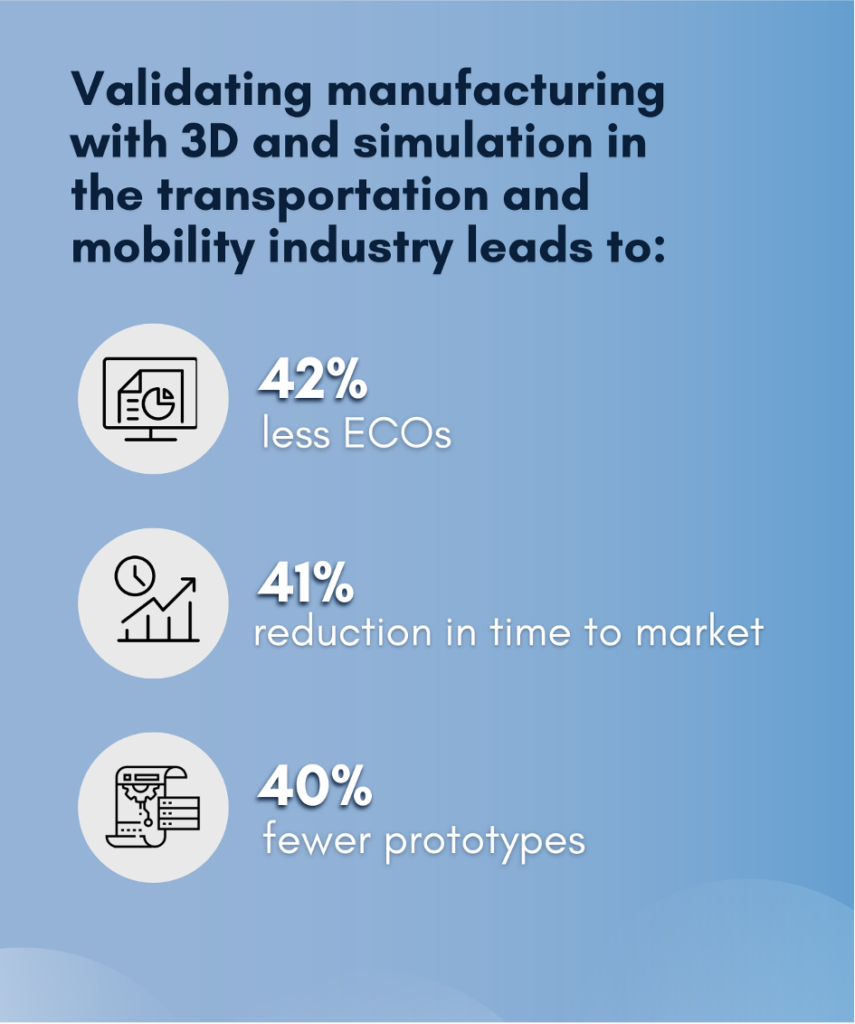 Conclusion
Conclusion
Based on the benchmark results, researchers concluded that transforming manufacturing engineering with increased use of 3D and simulation to plan, validate, and communicate manufacturing operations leads to measurably better manufacturing engineering performance.
*This summary is an abbreviated version of the research and does not contain the full content. For the full research, please visit our sponsor Dassault Systèmes DELMIA (registration required).
If you have difficulty obtaining a copy of the report, please contact us.
[post_title] => Transforming Manufacturing in the Transportation Industry
[post_excerpt] =>
[post_status] => publish
[comment_status] => open
[ping_status] => open
[post_password] =>
[post_name] => automotive-manufacturing-engineering
[to_ping] =>
[pinged] =>
[post_modified] => 2024-01-30 13:55:22
[post_modified_gmt] => 2024-01-30 18:55:22
[post_content_filtered] =>
[post_parent] => 0
[guid] => https://tech-clarity.com/?p=18640
[menu_order] => 0
[post_type] => post
[post_mime_type] =>
[comment_count] => 0
[filter] => raw
)
[2] => WP_Post Object
(
[ID] => 18915
[post_author] => 2574
[post_date] => 2023-09-18 10:00:11
[post_date_gmt] => 2023-09-18 14:00:11
[post_content] => 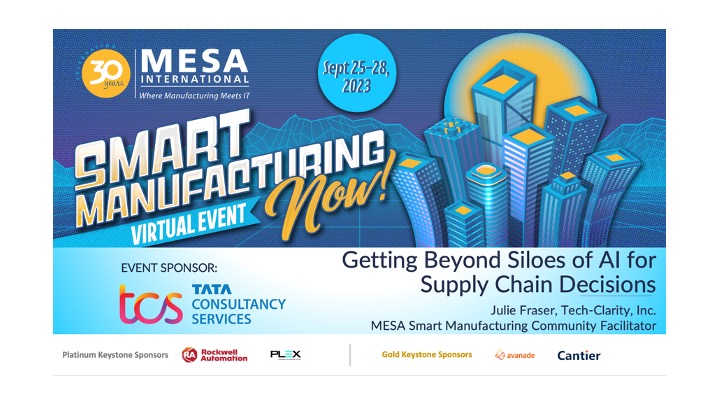 Artificial intelligence holds the promise of entirely new insights for better decision-making. However, is it doing that in your company today? Manufacturers have long suffered from discipline-specific or “siloes” of data and information. Increasingly, those siloes have their own specific AI or analytics.
September 27, day 3 of Smart Manufacturing Now, Julie Fraser will facilitate the discussion. Attendees were asked to bring their questions, thoughts, and experiences for this interactive short-version of the MESA Smart Manufacturing Community Supply Chain Group discussion.
Note that the Smart Manufacturing Community had these mini-sessions each day of the conference:
Monday 9/25 was Smart Manufacturing, Robotics, and Internal Logistics for Smart Connected Factory
Tuesday 9/26 New Capabilities in Manufacturing Operations Software
Thursday 9/28 Design for Manufacturing with Digital Thread and Digital Twin.
[post_title] => Getting Beyond Siloes of AI for Supply Chain Decisions
[post_excerpt] =>
[post_status] => publish
[comment_status] => open
[ping_status] => open
[post_password] =>
[post_name] => siloes-of-ai
[to_ping] =>
[pinged] =>
[post_modified] => 2023-12-07 18:26:30
[post_modified_gmt] => 2023-12-07 23:26:30
[post_content_filtered] =>
[post_parent] => 0
[guid] => https://tech-clarity.com/?p=18915
[menu_order] => 0
[post_type] => post
[post_mime_type] =>
[comment_count] => 0
[filter] => raw
)
[3] => WP_Post Object
(
[ID] => 18621
[post_author] => 2
[post_date] => 2023-09-13 10:12:35
[post_date_gmt] => 2023-09-13 14:12:35
[post_content] =>
Artificial intelligence holds the promise of entirely new insights for better decision-making. However, is it doing that in your company today? Manufacturers have long suffered from discipline-specific or “siloes” of data and information. Increasingly, those siloes have their own specific AI or analytics.
September 27, day 3 of Smart Manufacturing Now, Julie Fraser will facilitate the discussion. Attendees were asked to bring their questions, thoughts, and experiences for this interactive short-version of the MESA Smart Manufacturing Community Supply Chain Group discussion.
Note that the Smart Manufacturing Community had these mini-sessions each day of the conference:
Monday 9/25 was Smart Manufacturing, Robotics, and Internal Logistics for Smart Connected Factory
Tuesday 9/26 New Capabilities in Manufacturing Operations Software
Thursday 9/28 Design for Manufacturing with Digital Thread and Digital Twin.
[post_title] => Getting Beyond Siloes of AI for Supply Chain Decisions
[post_excerpt] =>
[post_status] => publish
[comment_status] => open
[ping_status] => open
[post_password] =>
[post_name] => siloes-of-ai
[to_ping] =>
[pinged] =>
[post_modified] => 2023-12-07 18:26:30
[post_modified_gmt] => 2023-12-07 23:26:30
[post_content_filtered] =>
[post_parent] => 0
[guid] => https://tech-clarity.com/?p=18915
[menu_order] => 0
[post_type] => post
[post_mime_type] =>
[comment_count] => 0
[filter] => raw
)
[3] => WP_Post Object
(
[ID] => 18621
[post_author] => 2
[post_date] => 2023-09-13 10:12:35
[post_date_gmt] => 2023-09-13 14:12:35
[post_content] => Takeaways from Hexagon Live 2023
I attended my first Hexagon Live user conference this year. It was a well-attended, high-energy, polished event. I have to say, the content reminded me of my first conversation with Hexagon at a COFES industry conference a few years ago where I was overwhelmed with the scope and depth of their offerings. Hexagon covers a number of key solutions areas with their portfolio, including Design & Engineering, Production, and Metrology offerings that span both software and hardware. Some recent additions include quality management (QMS), connected worker, and asset performance management (APM). We feel there is strong potential for synergy across these areas as manufacturers face a convergence of technologies that demand integrated solutions. Because of this, others in our analyst team including Michelle Boucher (engineering practices research) and Julie Fraser (operations and manufacturing research) are also keenly interested in Hexagon’s progress. Ironically, perhaps, the theme for COFES and my presentation the year I got to know Hexagon focused on technology convergence and how it impacts the engineering software industry. Vision and Platform President and CEO Paolo Guglielmini shared the Hexagon vision to deliver “digital twins of everything to improve and optimize at scale.” That’s a big goal. But Hexagon has a lot of solutions to apply toward that vision, having made over 170 acquisitions over the past 12 years. They plan to bring those together to create the “smart digital reality” that merges physical and virtual realities via the digital twin. This requires a lot of convergence and solution integration spanning both Hexagon products and the broader manufacturing and engineering software ecosystem. That’s where their new Nexus platform comes in, intended to be the platform to connect from the shop floor to the top floor. Hexagon launched Nexus earlier this year to support discrete manufacturing but has eyes on expanding to more industry segments.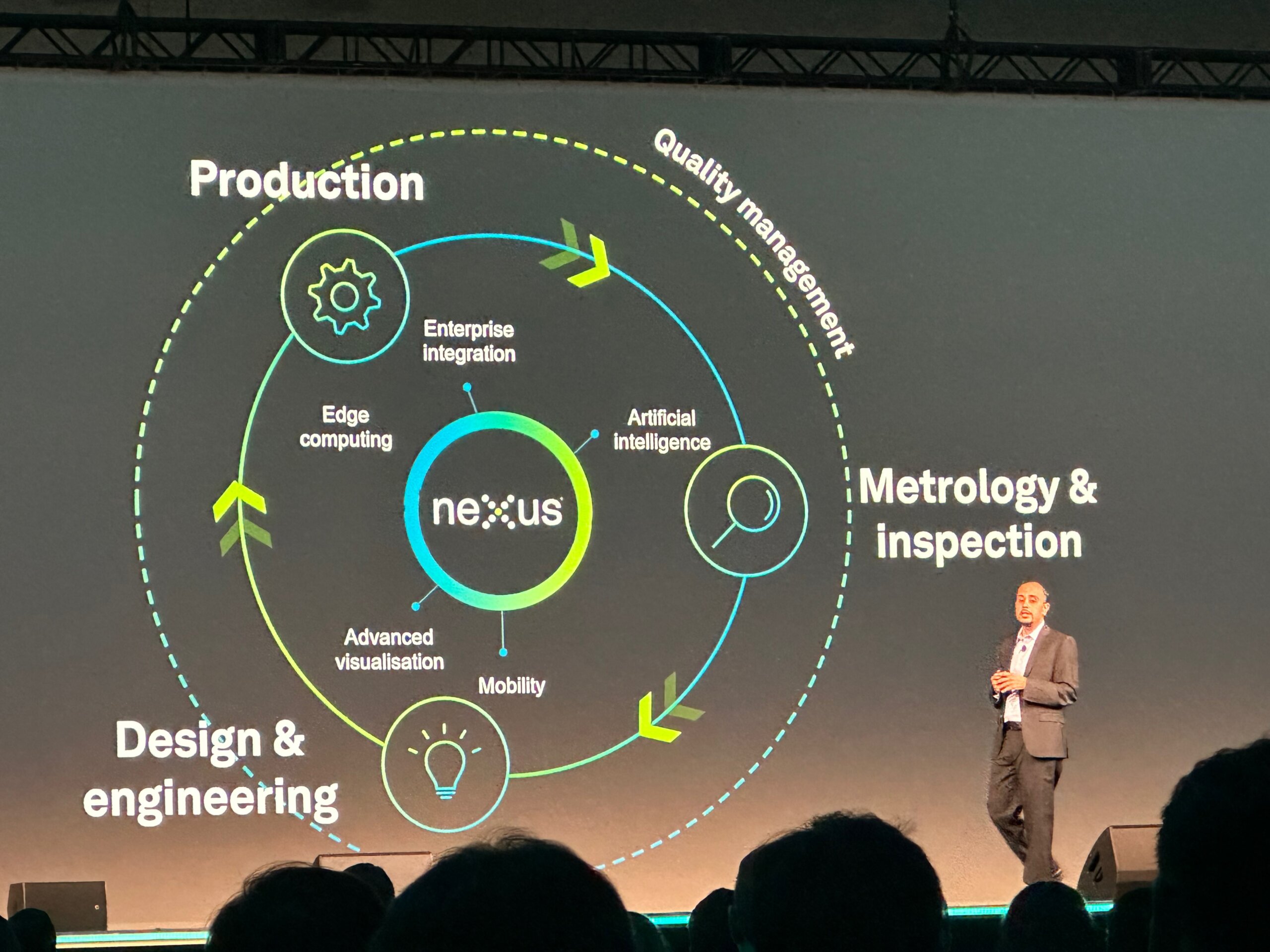 Nexus
I’m going to focus on Nexus because it’s new, it’s so important to the Hexagon vision, and it was one of my biggest takeaways from the conference. Why is it so important?
Nexus
I’m going to focus on Nexus because it’s new, it’s so important to the Hexagon vision, and it was one of my biggest takeaways from the conference. Why is it so important?
- It’s an opportunity for convergence
- It provides an opportunity for Hexagon partners
- It is the path to Hexagon’s future technology
- It’s a gateway to what we might expect from the industrial metaverse
 Two significant partners, NVIDIA and Microsoft, are already involved with Nexus. Jensen Huang, Founder and CEO of long-term partner NVIDIA, shared his vision for how Nexus and their Omniverse platform will work together to provide the benefits of AI to the industrial metaverse. Microsoft’s VP of Customer Innovation, Andy Pratt, shared how Nexus will support digital twins. It’s clear that a lot of thought has already been put into these partnerships around Nexus.
Beyond these larger partners, Hexagon announced Nexus for Developers at the conference. This capability provides APIs, SDKs, templates, and training that allow partners to build native apps, custom workflows, and “powered by Nexus communities.” They shared that their partner Altium was the first to pilot Nexus for Developers by creating a new solution for the electronics industry.
By opening up the platform, Hexagon provides partners (and customers) the opportunity to innovate and do more with their solutions than Hexagon can offer on their own.
Path to the Future
Nexus is a significant part of Hexagon’s future technology plans and they are using it to build the next generation of their applications and create a path to the cloud. They’ve already launched a number of apps and are in the process of introducing more. In addition, they are developing more platform capabilities that can be leveraged by both Nexus and partner applications. There is more detail here than I can cover, I encourage you to look at their roadmap to learn more as it is growing rapidly.
One of the important things to recognize about Nexus is that it’s not a replacement for existing systems. EVP and Nexus GM Stephen Graham explained that Nexus is intended to complement enterprise systems. It’s focused more on agility than control and works more as a system of engagement as compared to a typical system of record (like PLM). Nexus will bring automation and enable new feedback loops that will make processes more automated, efficient, and flexible. It will enhance current solutions by adding AI and visualization and support integration across solutions. This allows Hexagon to leverage their current solutions more effectively while they build out future offerings. The introduction of systems of engagement is an exciting new trend that we’re following closely, and Hexagon looks well aligned to help customers get more from their systems of record.
Industrial Metaverse
There is a lot of hype around the industrial metaverse. Beyond all of the hype, there is also value. With Nexus, Hexagon’s solutions offer the ability to connect real-world performance from the physical world with the digital twin. Their goal is to leverage simulation and AI to improve designs and the real world. Beyond that, Nexus has a goal to automate decisions in real-time to increase value by acting in the real world. This is an area that we look forward to learning more about. Look for more autonomy from Hexagon and Nexus in the future.
It’s also an area where partner collaboration, for example with NVIDIA, offers the potential for a lot of future innovation. For example, VP of Omniverse & Simulation Technology for NVIDIA Rev Lebaredian explained how companies can combine and simulate designs earlier to save money, reduce waste, and increase sustainability. He shared an example where companies with complex factories could bring together digital twins of a variety of assets, such as buildings, conveyors, robotics, and other equipment from different suppliers to simulate and find problems earlier. The potential is compelling.
Wrapping Up
Nexus is a significant new direction for Hexagon. It’s still relatively early, but their vision is strong and they’ve demonstrated real progress.
There was a lot more to the conference, but I hope this is a start in understanding what’s new with Hexagon. Thank you Robin Wolstenhome and Fiona Batchelor for your help coordinating schedules and customer discussions as I navigated my first Hexagon Live experience, and to countless Hexagon leaders who helped me learn more about Hexagon and their solutions.
Two significant partners, NVIDIA and Microsoft, are already involved with Nexus. Jensen Huang, Founder and CEO of long-term partner NVIDIA, shared his vision for how Nexus and their Omniverse platform will work together to provide the benefits of AI to the industrial metaverse. Microsoft’s VP of Customer Innovation, Andy Pratt, shared how Nexus will support digital twins. It’s clear that a lot of thought has already been put into these partnerships around Nexus.
Beyond these larger partners, Hexagon announced Nexus for Developers at the conference. This capability provides APIs, SDKs, templates, and training that allow partners to build native apps, custom workflows, and “powered by Nexus communities.” They shared that their partner Altium was the first to pilot Nexus for Developers by creating a new solution for the electronics industry.
By opening up the platform, Hexagon provides partners (and customers) the opportunity to innovate and do more with their solutions than Hexagon can offer on their own.
Path to the Future
Nexus is a significant part of Hexagon’s future technology plans and they are using it to build the next generation of their applications and create a path to the cloud. They’ve already launched a number of apps and are in the process of introducing more. In addition, they are developing more platform capabilities that can be leveraged by both Nexus and partner applications. There is more detail here than I can cover, I encourage you to look at their roadmap to learn more as it is growing rapidly.
One of the important things to recognize about Nexus is that it’s not a replacement for existing systems. EVP and Nexus GM Stephen Graham explained that Nexus is intended to complement enterprise systems. It’s focused more on agility than control and works more as a system of engagement as compared to a typical system of record (like PLM). Nexus will bring automation and enable new feedback loops that will make processes more automated, efficient, and flexible. It will enhance current solutions by adding AI and visualization and support integration across solutions. This allows Hexagon to leverage their current solutions more effectively while they build out future offerings. The introduction of systems of engagement is an exciting new trend that we’re following closely, and Hexagon looks well aligned to help customers get more from their systems of record.
Industrial Metaverse
There is a lot of hype around the industrial metaverse. Beyond all of the hype, there is also value. With Nexus, Hexagon’s solutions offer the ability to connect real-world performance from the physical world with the digital twin. Their goal is to leverage simulation and AI to improve designs and the real world. Beyond that, Nexus has a goal to automate decisions in real-time to increase value by acting in the real world. This is an area that we look forward to learning more about. Look for more autonomy from Hexagon and Nexus in the future.
It’s also an area where partner collaboration, for example with NVIDIA, offers the potential for a lot of future innovation. For example, VP of Omniverse & Simulation Technology for NVIDIA Rev Lebaredian explained how companies can combine and simulate designs earlier to save money, reduce waste, and increase sustainability. He shared an example where companies with complex factories could bring together digital twins of a variety of assets, such as buildings, conveyors, robotics, and other equipment from different suppliers to simulate and find problems earlier. The potential is compelling.
Wrapping Up
Nexus is a significant new direction for Hexagon. It’s still relatively early, but their vision is strong and they’ve demonstrated real progress.
There was a lot more to the conference, but I hope this is a start in understanding what’s new with Hexagon. Thank you Robin Wolstenhome and Fiona Batchelor for your help coordinating schedules and customer discussions as I navigated my first Hexagon Live experience, and to countless Hexagon leaders who helped me learn more about Hexagon and their solutions.
You can read our initial reaction to the Nexus announcement here.
[post_title] => Takeaways from Hexagon Live 2023 [post_excerpt] => [post_status] => publish [comment_status] => open [ping_status] => open [post_password] => [post_name] => hexagon-live [to_ping] => [pinged] => [post_modified] => 2023-10-24 09:20:14 [post_modified_gmt] => 2023-10-24 13:20:14 [post_content_filtered] => [post_parent] => 0 [guid] => https://tech-clarity.com/?p=18621 [menu_order] => 0 [post_type] => post [post_mime_type] => [comment_count] => 0 [filter] => raw ) [4] => WP_Post Object ( [ID] => 18598 [post_author] => 2 [post_date] => 2023-09-13 09:00:35 [post_date_gmt] => 2023-09-13 13:00:35 [post_content] =>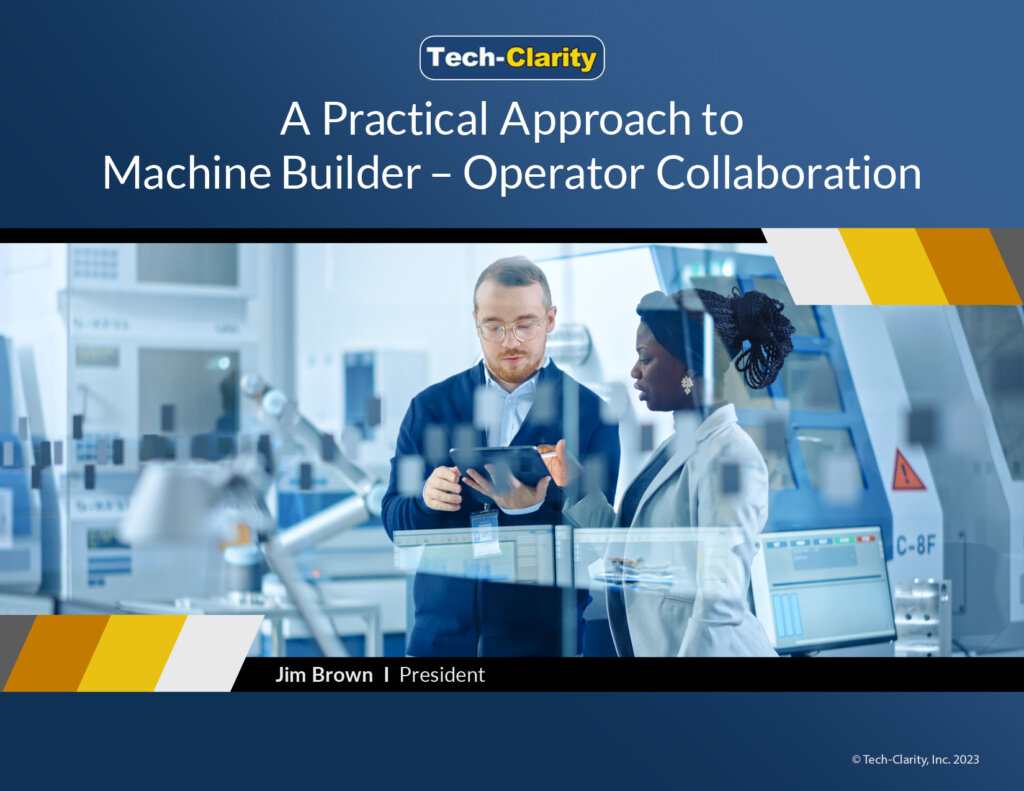 How can machine builders improve the way they work with the companies that use their products to create more collaborative, mutually valuable relationships? This eBook explores five practical steps manufacturers can take to improve machine builder – operator collaboration and increase value for both themselves and the customers operating their machines.
Please enjoy the summary below and visit our sponsor Siemens to learn more about digital manufacturing solutions machine builders. You can also download the full eBook to learn more.
For related research, please read prior eBooks, The Machine Builder Digital Twin, Increasing Equipment Design Velocity, and Increasing Performance Engineering Performance.
How can machine builders improve the way they work with the companies that use their products to create more collaborative, mutually valuable relationships? This eBook explores five practical steps manufacturers can take to improve machine builder – operator collaboration and increase value for both themselves and the customers operating their machines.
Please enjoy the summary below and visit our sponsor Siemens to learn more about digital manufacturing solutions machine builders. You can also download the full eBook to learn more.
For related research, please read prior eBooks, The Machine Builder Digital Twin, Increasing Equipment Design Velocity, and Increasing Performance Engineering Performance.
Table of Contents
- Recognize the Opportunity
- The Value of Machine Builder - Operator Collaboration
- Take a Practical Approach with Room to Grow
- 1. Improve Equipment Data
- 2. Improve Service Response
- 3. Connect and Communicate
- 4. Increase Predictive Capabilities
- Get Started
- Acknowledgments
Has the Time for Servitization Finally Arrived?
The Service Relationship is Changing The relationship between machine builders, their products, and their customers is evolving. Many machine builders who traditionally followed "sell it and forget it" or "service it because you have to" models are moving to more closely aligned service relationships. Why? Manufacturers recognize they have a strategic opportunity to drive higher revenue and better profit margins by transforming their service approach. And in some cases, their customers demand it because they need to get the most out of increasingly complex machines to drive their own productivity and profitability. Time for a Practical Approach This shift is not new. Service transformation, sometimes called "servitization," has been discussed for well over a decade. We wrote about the trend in The Service Lifecycle Management Approach as far back as 2003. Since then, some companies and industries have made progress. The concept is well defined, and the enabling technology has come a long way. But few machine OEMs have been able to fully embrace the model, and reaching the highest level of service maturity still faces people, process, and technology challenges. Fortunately, it's not an "all or nothing" proposition. Machine builders have plenty of room to improve. And, even if they never reach the ultimate goal, there is value along the way.Recognize the Opportunity
Improving Service Benefits OEMs and Operators Improving service performance is a win-win. It brings machine builders new revenue, higher margins, better customer relationships, and a steadier income stream. In addition, transformation can provide strategic value by creating machine performance knowledge to improve engineering. It can also support significant business transformation, opening up the potential for new business models like "Product as a Service" (PaaS) or "Machines as a Service" (MaaS), where the machine builder takes on responsibility for delivering productivity instead of hardware. Finally, it can improve sustainability by optimizing energy use and supporting circular economics where machines could be resold, remanufactured, or harvested for valuable components and materials instead of scrapped. Transformation also helps customers better operate and maintain increasingly complex equipment. In turn, it allows them to increase uptime, plan for downtime, raise productivity, optimize performance, improve efficiency, reduce cost, and cut power consumption. The Potential for Transformation is Proven The value of improving service through tighter relationships and digital transformation is well documented. There are practical examples to follow. Other industries, including aerospace, have paved the way, proven the value, and developed best practices. There are experienced consultancies that know how to transform to servitization. Supporting technologies, including the Industrial Internet of Things (IIoT), analytics, Enterprise Asset Management (EAM), and Service Lifecycle Management (SLM), are more mature and accessible. The Potential for Transformation is Proven It's hard to argue with the value, but it's a significant change. Technology has advanced faster than companies can adapt. Collaboration requires a level of trust and accountability between partners. Some operators may not want their data connected to the internet or consider their operational data and processes part of their intellectual property and be reluctant to share it. Making the transition can also be a financial hurdle. Shifting how and when manufacturers record revenue is a major change, especially for those producing expensive machinery.
Take a Practical Approach with Room to Grow
Innovate, Experiment, Learn, and Improve Although the vision is more attainable, it may not be easy for every company to achieve. What can machine builders do now to start down the path toward value? We recommend that they understand the big picture but start small. But starting small doesn't mean the project has to be limited to a proof of concept. There are practical ways to create value now and make progress toward the future state as they gain experience improving service in a digital model. Machine builders can take tangible steps toward greater maturity by:- Improving collaboration with their customers
- Learning from the experience
- Repeating what works
- Extending their success
- Expanding to new areas
- What challenges do your customers face while operating your equipment?
- What would they value if you could change the situation?
- What would “change the game” for them?
- What are they willing to pay for it so that you can share in that value?
Get Started
Start Small, Then Expand Although few machine builders have reached the highest level of digital transformation maturity, it's essential to get started. These techniques are becoming more prevalent and achievable. It's time to collaborate on a small but meaningful project that solves a real problem. This project should provide benefits for both the machine builder and the operator. Choose a product line or focused use case and take an agile approach that gains value with a "minimum viable product" approach. Keep it simple so you, and your partner, can learn and extend based on experience. Manage Change Lastly, remember to manage the change. Educating management, personnel, and customers about the change and why it is valuable to them is critical. Next, develop a plan that addresses both business and technical requirements, and engage with engineers, operators, and service technicians to learn from their knowledge. Then, get started to create an advantage on your timeline before being forced to react to competitive threats. If you have difficulty obtaining a copy of the report, please contact us. [post_title] => Machine Builder-Operator Collaboration [post_excerpt] => [post_status] => publish [comment_status] => open [ping_status] => open [post_password] => [post_name] => machine-builder-collaboration [to_ping] => [pinged] => [post_modified] => 2024-02-20 12:30:38 [post_modified_gmt] => 2024-02-20 17:30:38 [post_content_filtered] => [post_parent] => 0 [guid] => https://tech-clarity.com/?p=18598 [menu_order] => 0 [post_type] => post [post_mime_type] => [comment_count] => 0 [filter] => raw ) [5] => WP_Post Object ( [ID] => 18568 [post_author] => 2574 [post_date] => 2023-09-12 08:30:27 [post_date_gmt] => 2023-09-12 12:30:27 [post_content] => Can lithium-ion and other specialty battery manufacturers keep up with the growth potential in the new world fueled by electrons rather than heat? That all depends on how well they can master manufacturing. Lithium-ion batteries are inherently complex. It is an enormous challenge to make them at consistently high quality. Compounding the challenge are the ever-shifting conditions: constant innovation in materials, chemistry, and form factors plus frequent changes based on customer requirements and applications. Manufacturing prowess well could differentiate a company and set it up for success. Making these batteries is a multi-mode, sensitive operation. There are interdependencies between steps, opportunities for contamination and human error, and the final product’s selling price depends on manufacturing excellence. In addition, new chemistry, form factors, and approaches are emerging for new applications, so there’s a steady stream of experiments and new products in the mix. All of these factors mean a manufacturing execution system (MES) is required. This is the only type of system that can support all aspects needed for success in this complex production environment. Yet, not just any MES will do. Five key characteristics make an MES capable of supporting Lithium-ion and specialty battery manufacturers. Multi-mode support is paramount for batch slurry mixing, roll, winding, assembly, sealing, and testing. Flexibility for the high mix and R&D experimentation is also fundamental. Read the entire blog post by clicking on the image on LinkedIn to learn more about these characteristics battery manufacturers should seek in MES, plus discover the other three. Thank you to Eyelit for supporting us in expressing our views on the important features of MES for battery manufacturers.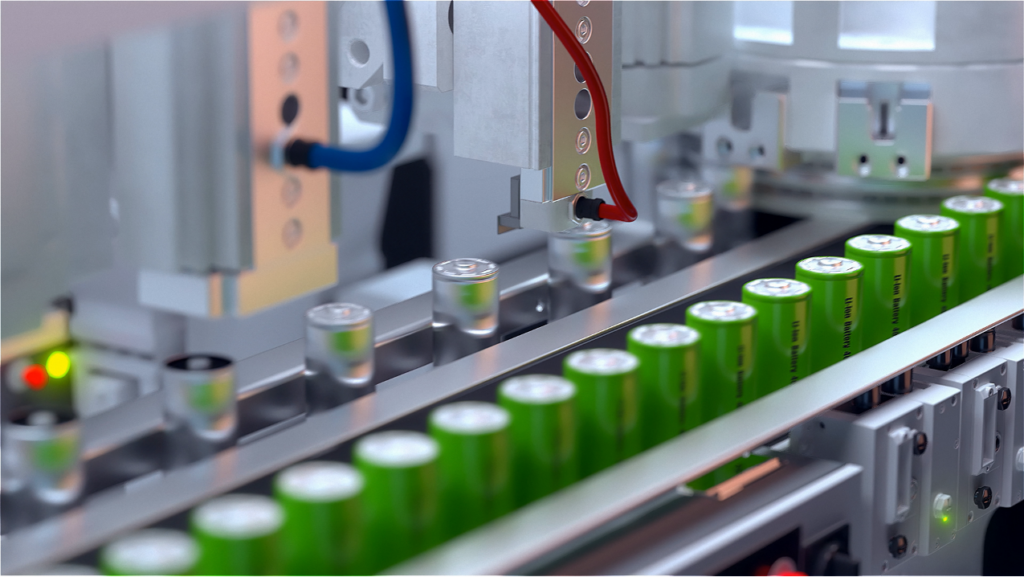 [post_title] => Five Software Characteristics Battery Manufacturers Need to Succeed (Guest Post)
[post_excerpt] =>
[post_status] => publish
[comment_status] => open
[ping_status] => open
[post_password] =>
[post_name] => battery-manufacturers-guest-post
[to_ping] =>
[pinged] =>
[post_modified] => 2023-12-26 16:08:15
[post_modified_gmt] => 2023-12-26 21:08:15
[post_content_filtered] =>
[post_parent] => 0
[guid] => https://tech-clarity.com/?p=18568
[menu_order] => 0
[post_type] => post
[post_mime_type] =>
[comment_count] => 0
[filter] => raw
)
[6] => WP_Post Object
(
[ID] => 18535
[post_author] => 2574
[post_date] => 2023-09-11 09:00:07
[post_date_gmt] => 2023-09-11 13:00:07
[post_content] =>
[post_title] => Five Software Characteristics Battery Manufacturers Need to Succeed (Guest Post)
[post_excerpt] =>
[post_status] => publish
[comment_status] => open
[ping_status] => open
[post_password] =>
[post_name] => battery-manufacturers-guest-post
[to_ping] =>
[pinged] =>
[post_modified] => 2023-12-26 16:08:15
[post_modified_gmt] => 2023-12-26 21:08:15
[post_content_filtered] =>
[post_parent] => 0
[guid] => https://tech-clarity.com/?p=18568
[menu_order] => 0
[post_type] => post
[post_mime_type] =>
[comment_count] => 0
[filter] => raw
)
[6] => WP_Post Object
(
[ID] => 18535
[post_author] => 2574
[post_date] => 2023-09-11 09:00:07
[post_date_gmt] => 2023-09-11 13:00:07
[post_content] =>  How can a Center of Excellence (CoE) prevent common challenges with manufacturing operations management (MOM)? In this new book published by ISA, long-time consultant Grant Vokey explains the functions and structure of successful CoEs. This solid book has sections to support data-driven management, continuous improvement (CI), Industry 4.0, manufacturing execution system (MES) implementations, and strategic planning and management.
Tech-Clarity’s Julie Fraser reviewed this book in draft form and provided input on an excellent manuscript. The Tech-Clarity survey eBook The Manufacturing Data Challenge research is cited several times to illustrate common challenges and show the keys to success.
This CoE book builds logically from background materials into more specific whys, hows, and keys to success. The book includes information about standard ISA topics such as MOM, ISA-95, and ISO 9000. It has valuable illustrations to support deeper understanding. Julie's favorite parts are the easy-to-follow examples and real-life experiences from Grant's career that bring home the value of a CoE.
Thanks to Grant Vokey and the ISA publishing team for providing us the opportunity to support this work. We believe many manufacturers will benefit from the logical flow of this book and the range of topics it covers for a CoE to support excellence in operations.
[post_title] => Tech-Clarity Research in New ISA Book CoE: The Key To Data-Driven Manufacturing
[post_excerpt] =>
[post_status] => publish
[comment_status] => open
[ping_status] => open
[post_password] =>
[post_name] => center-of-excellence
[to_ping] =>
[pinged] =>
[post_modified] => 2023-09-11 13:20:06
[post_modified_gmt] => 2023-09-11 17:20:06
[post_content_filtered] =>
[post_parent] => 0
[guid] => https://tech-clarity.com/?p=18535
[menu_order] => 0
[post_type] => post
[post_mime_type] =>
[comment_count] => 0
[filter] => raw
)
[7] => WP_Post Object
(
[ID] => 18550
[post_author] => 2
[post_date] => 2023-09-07 09:00:37
[post_date_gmt] => 2023-09-07 13:00:37
[post_content] =>
How can a Center of Excellence (CoE) prevent common challenges with manufacturing operations management (MOM)? In this new book published by ISA, long-time consultant Grant Vokey explains the functions and structure of successful CoEs. This solid book has sections to support data-driven management, continuous improvement (CI), Industry 4.0, manufacturing execution system (MES) implementations, and strategic planning and management.
Tech-Clarity’s Julie Fraser reviewed this book in draft form and provided input on an excellent manuscript. The Tech-Clarity survey eBook The Manufacturing Data Challenge research is cited several times to illustrate common challenges and show the keys to success.
This CoE book builds logically from background materials into more specific whys, hows, and keys to success. The book includes information about standard ISA topics such as MOM, ISA-95, and ISO 9000. It has valuable illustrations to support deeper understanding. Julie's favorite parts are the easy-to-follow examples and real-life experiences from Grant's career that bring home the value of a CoE.
Thanks to Grant Vokey and the ISA publishing team for providing us the opportunity to support this work. We believe many manufacturers will benefit from the logical flow of this book and the range of topics it covers for a CoE to support excellence in operations.
[post_title] => Tech-Clarity Research in New ISA Book CoE: The Key To Data-Driven Manufacturing
[post_excerpt] =>
[post_status] => publish
[comment_status] => open
[ping_status] => open
[post_password] =>
[post_name] => center-of-excellence
[to_ping] =>
[pinged] =>
[post_modified] => 2023-09-11 13:20:06
[post_modified_gmt] => 2023-09-11 17:20:06
[post_content_filtered] =>
[post_parent] => 0
[guid] => https://tech-clarity.com/?p=18535
[menu_order] => 0
[post_type] => post
[post_mime_type] =>
[comment_count] => 0
[filter] => raw
)
[7] => WP_Post Object
(
[ID] => 18550
[post_author] => 2
[post_date] => 2023-09-07 09:00:37
[post_date_gmt] => 2023-09-07 13:00:37
[post_content] => 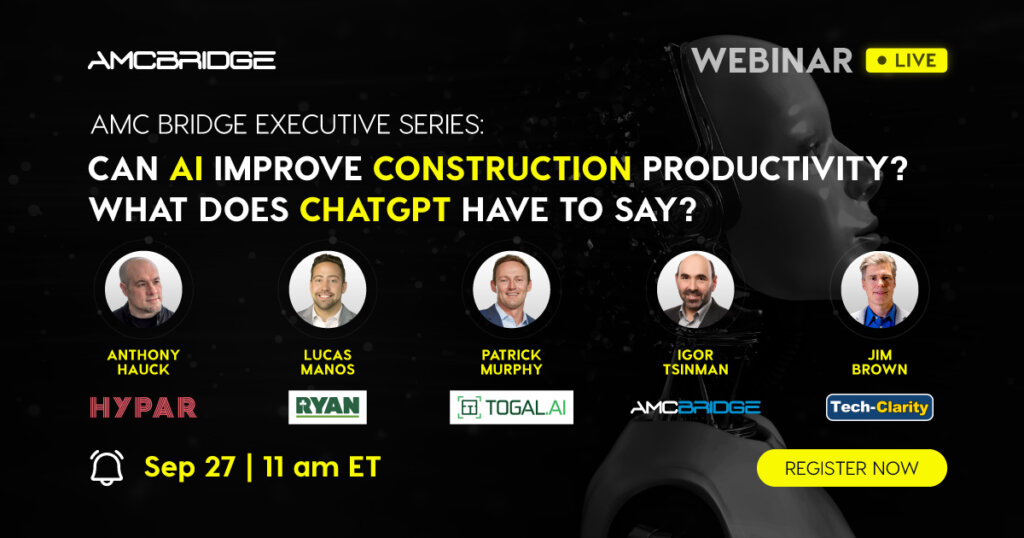 With all of the excitement about artificial intelligence, in part generated by the publicity generated by ChatGPT, what are the practical ways AI in construction can improve performance and profitability?
Jim Brown will moderate a panel of practitioners and technology innovators to discuss real-world implementations for AI in construction. The panelists include:
With all of the excitement about artificial intelligence, in part generated by the publicity generated by ChatGPT, what are the practical ways AI in construction can improve performance and profitability?
Jim Brown will moderate a panel of practitioners and technology innovators to discuss real-world implementations for AI in construction. The panelists include:
- Anthony Hauck, Co-Founder and Chief Product Officer, Hypar
- Lucas Manos, IT Director of Business Operations, Ryan Companies
- Patrick Murphy, CEO and Founder, Togal.AI
- Igor Tsinman, President, AMC Bridge
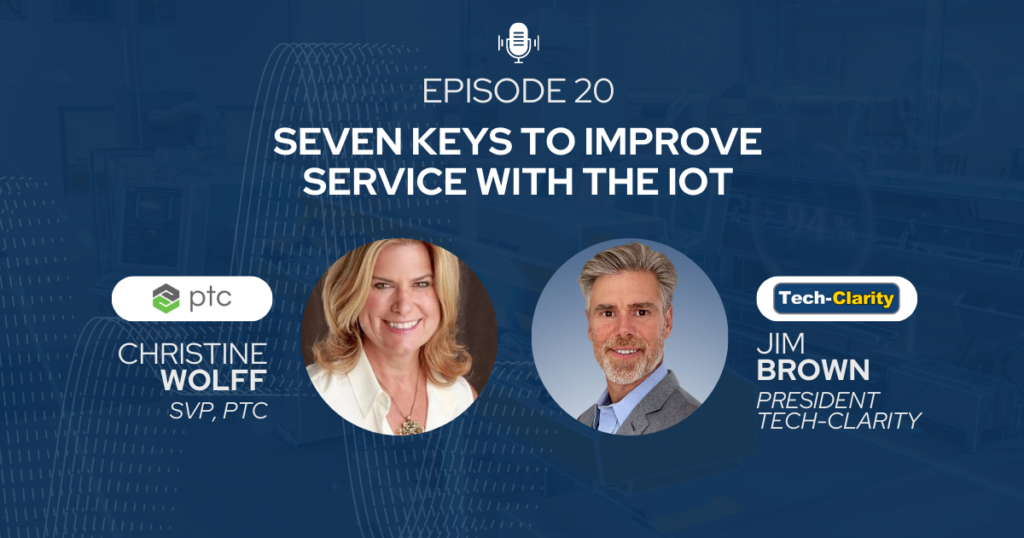 Jim Brown joined PTC’s VP of Strategy Partnership, Christine Wolff, to share his thoughts about improving field service by leveraging the IoT in episode 20 of PTC's Speaking of Service Podcast. Jim and “Wolffie” discuss the importance of service transformation given current economic conditions that make profitability and asset longevity crucial.
Jim Brown joined PTC’s VP of Strategy Partnership, Christine Wolff, to share his thoughts about improving field service by leveraging the IoT in episode 20 of PTC's Speaking of Service Podcast. Jim and “Wolffie” discuss the importance of service transformation given current economic conditions that make profitability and asset longevity crucial.  Jim shares insights from his recent Buyer’s Guide including why to start with a business strategy instead of taking a technology-driven approach and shares seven areas companies can focus on to drive better service performance and profitability.
For more details from the podcast and how to achieve service transformation with the IoT, please see our Buyer’s Guide on Improving Service with IoT.
[post_title] => Speaking of Service: Seven Ways to Improve Service with IoT
[post_excerpt] =>
[post_status] => publish
[comment_status] => open
[ping_status] => open
[post_password] =>
[post_name] => service-transformation-podcast
[to_ping] =>
[pinged] =>
[post_modified] => 2024-11-11 16:21:40
[post_modified_gmt] => 2024-11-11 21:21:40
[post_content_filtered] =>
[post_parent] => 0
[guid] => https://tech-clarity.com/?p=18514
[menu_order] => 0
[post_type] => post
[post_mime_type] =>
[comment_count] => 0
[filter] => raw
)
[9] => WP_Post Object
(
[ID] => 18515
[post_author] => 2
[post_date] => 2023-08-28 09:00:57
[post_date_gmt] => 2023-08-28 13:00:57
[post_content] =>
Jim shares insights from his recent Buyer’s Guide including why to start with a business strategy instead of taking a technology-driven approach and shares seven areas companies can focus on to drive better service performance and profitability.
For more details from the podcast and how to achieve service transformation with the IoT, please see our Buyer’s Guide on Improving Service with IoT.
[post_title] => Speaking of Service: Seven Ways to Improve Service with IoT
[post_excerpt] =>
[post_status] => publish
[comment_status] => open
[ping_status] => open
[post_password] =>
[post_name] => service-transformation-podcast
[to_ping] =>
[pinged] =>
[post_modified] => 2024-11-11 16:21:40
[post_modified_gmt] => 2024-11-11 21:21:40
[post_content_filtered] =>
[post_parent] => 0
[guid] => https://tech-clarity.com/?p=18514
[menu_order] => 0
[post_type] => post
[post_mime_type] =>
[comment_count] => 0
[filter] => raw
)
[9] => WP_Post Object
(
[ID] => 18515
[post_author] => 2
[post_date] => 2023-08-28 09:00:57
[post_date_gmt] => 2023-08-28 13:00:57
[post_content] => 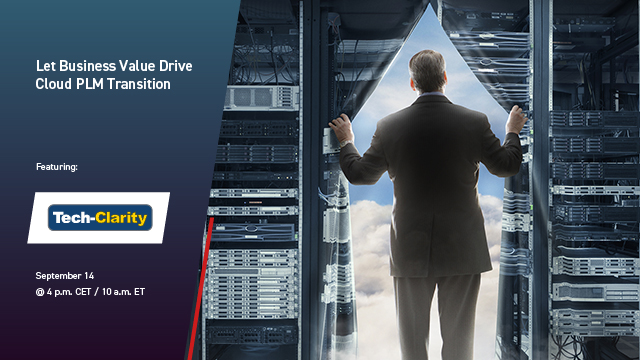 The cloud PLM transition is underway in the manufacturing industry. How should companies make the transition? I’m joining this webinar to share my latest research on SaaS PLM and discuss our PLM selection recommendations with Aras’ Bruce Bookbinder.
Whether your company is moving to SaaS PLM because it’s time to update your old system or for more strategic reasons like digital transformation (or both), it’s important to understand and prioritize the different kinds of value that the cloud can offer. We’ll discuss a variety of options and their implications on achieving business value.
Please join this Aras-sponsored webinar on September 14th at 10AM EST / 4PM CET.
For background information for the webinar or to learn more about the cloud PLM transition, please read our eBook: Seven Keys to Improving Service with the IoT.
The cloud PLM transition is underway in the manufacturing industry. How should companies make the transition? I’m joining this webinar to share my latest research on SaaS PLM and discuss our PLM selection recommendations with Aras’ Bruce Bookbinder.
Whether your company is moving to SaaS PLM because it’s time to update your old system or for more strategic reasons like digital transformation (or both), it’s important to understand and prioritize the different kinds of value that the cloud can offer. We’ll discuss a variety of options and their implications on achieving business value.
Please join this Aras-sponsored webinar on September 14th at 10AM EST / 4PM CET.
For background information for the webinar or to learn more about the cloud PLM transition, please read our eBook: Seven Keys to Improving Service with the IoT. [post_title] => Let Business Value Drive Your Cloud PLM Transition [post_excerpt] => [post_status] => publish [comment_status] => open [ping_status] => open [post_password] => [post_name] => cloud-plm-transition-webinar [to_ping] => [pinged] => [post_modified] => 2023-12-15 14:54:01 [post_modified_gmt] => 2023-12-15 19:54:01 [post_content_filtered] => [post_parent] => 0 [guid] => https://tech-clarity.com/?p=18515 [menu_order] => 0 [post_type] => post [post_mime_type] => [comment_count] => 0 [filter] => raw ) [10] => WP_Post Object ( [ID] => 18469 [post_author] => 2574 [post_date] => 2023-08-03 08:00:08 [post_date_gmt] => 2023-08-03 12:00:08 [post_content] =>
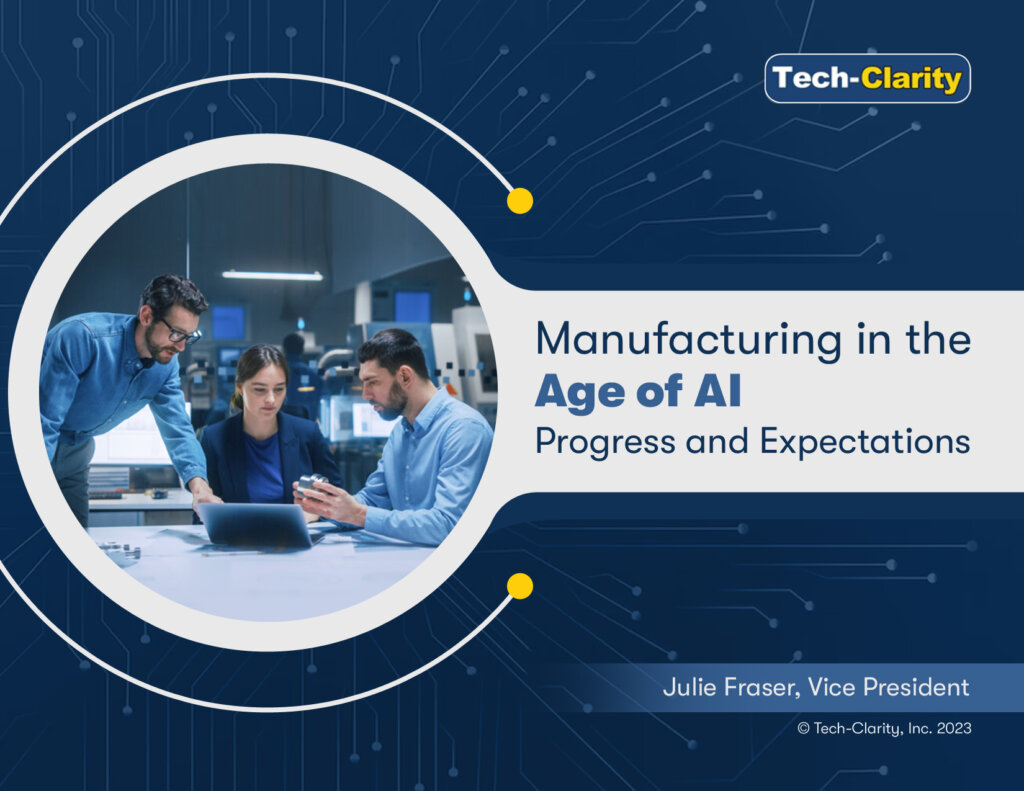 What defines Manufacturing in the Age of AI? How much progress are companies making toward Industry 4.0? What data management elements have leading manufactures put in place to support rapid decisions? Our eBook Manufacturing in the Age of AI explains the findings of our survey of over 300 manufacturing professionals. It reveals answers to these questions and more.
Please enjoy the summary* below. For the full research, please visit our sponsor Critical Manufacturing (registration required).
For additional research, please read our Manufacturing Data Challenge eBook exploring explores the many challenges and lessons in Industry 4.0. Additional content includes The Challenge of Manufacturing Data Management article and a recorded a session of the webinar revealing significant findings of research on the topic of manufacturing data management.
What defines Manufacturing in the Age of AI? How much progress are companies making toward Industry 4.0? What data management elements have leading manufactures put in place to support rapid decisions? Our eBook Manufacturing in the Age of AI explains the findings of our survey of over 300 manufacturing professionals. It reveals answers to these questions and more.
Please enjoy the summary* below. For the full research, please visit our sponsor Critical Manufacturing (registration required).
For additional research, please read our Manufacturing Data Challenge eBook exploring explores the many challenges and lessons in Industry 4.0. Additional content includes The Challenge of Manufacturing Data Management article and a recorded a session of the webinar revealing significant findings of research on the topic of manufacturing data management.
Table of Contents
- Progress on Industry 4.0
- Difficult Environment
- Keys to Success
- Closing the Loop from Data to Action
- Multiple Aspects to Master
- Challenges in Manufacturing Data Management
- Integration Still Obstructs Purpose
- Improvement is Possible: Top Performers
- Understand All the Issues Matter
- Launch Initiatives to Address the Issues
- Improve Organizational Structure
- Succeed in Staffing
- Overcoming Skills Shortages
- Leverage Commercial Applications
- Have Better Experience with MES
- Explore Advanced Technologies
- Gain Business Capabilities
- Accelerate Improvement
- Meet Cost Targets
- Why Manufacturing Data Management
- Why Drive to AI?
- Quotes: Selected Benefits of Advanced Analytics
- The Path Ahead
- About the Research
- Acknowledgments
Speeding the Loop from Data to Effective Action
A New AI-driven Era for Manufacturing Despite challenging supply chain situations, manufacturers are making progress toward Industry 4.0. Most understand that artificial intelligence (AI) and improved analytics can lead to better decisions and, thus, business benefits. However, creating the data management structure for success is something many are still learning. This research shows how Top Performing companies are making more significant strides than others. In short, they understand, invest in, and make the most of many aspects of people, process, and technology. Together, they enable capabilities that close the loop from data to information to insights to decisions and to profitable, timely action.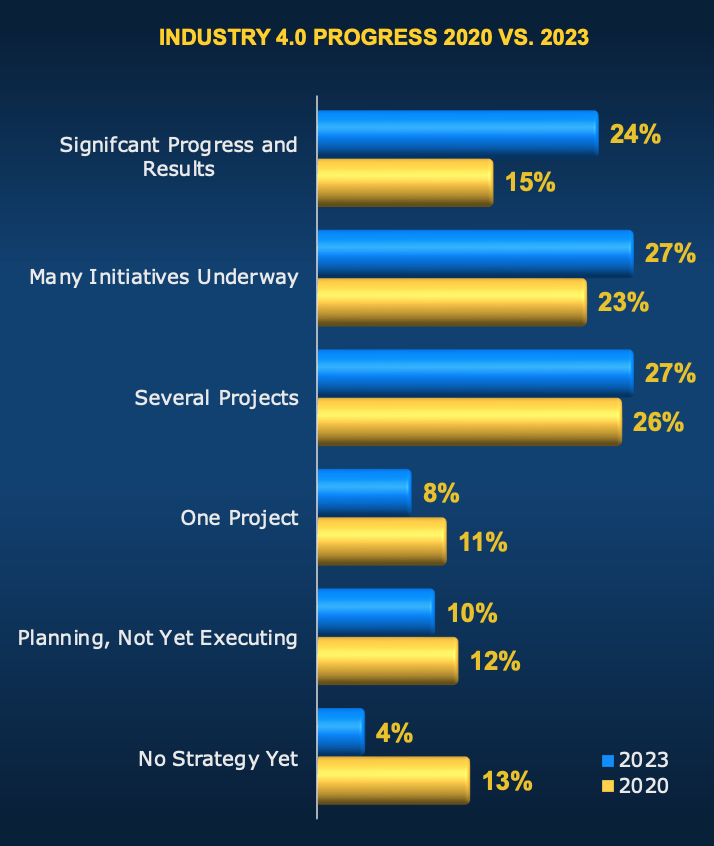
Progress on Industry 4.0
Industry 4.0 Vision The future of manufacturing is more flexible, agile, and responsive based on AI and intelligent automation. This is the vision of Industry 4.0, which goes by many other names. While the concept encompasses the entire enterprise and supply chain, the manufacturing area often poses the most significant challenges and opportunities for gaining substantial benefits. Three Years of Progress When manufacturers embark on an Industry 4.0 initiative, they typically know it will be a multi-year journey. What we see is that most companies are now well on their way. There has been clear progress since our survey, The Manufacturing Data Management Challenge,1 in 2020. A much more significant percentage of respondents’ companies have made tremendous progress toward Industry 4.0 and gained benefits already.Why Drive to AI?
Many Applications This is the age of AI. Just as human intelligence can address many topics, so can artificial intelligence. We asked, “Where would your company anticipate benefits from using advanced analytics in the plant such as artificial intelligence (AI), machine learning (ML), predictive, or prescriptive analytics? (list all processes, areas, or disciplines). The responses varied widely, as the word cloud shows. Top of Mind The most common benefits these respondents see are in production: quality, productivity, efficiency, yield, maintenance, safety, costs, and control. They also cite error-proofing, speed, and efficiency. In addition, they see benefits across the business, including for management, training, supply chain, revenue, engineering change, marketing, fraud detection, and customer service.The Path Ahead
Next Steps The manufacturers in this survey, including the Top Performers, know they are on an ongoing journey. Every company must ask themselves what their next steps are. Depending on the state of your capabilities and processes, the answer will vary. Recommendations- Recognize that Industry 4.0 is a journey, and manufacturers can only expect to get benefits once they have made significant progress.
- In the face of complex and unpredictable external circumstances, invest in internal understanding, initiatives and projects, staff, and capability-building technologies.
- Be sure everyone - top floor to shop floor - understands Industry 4.0 has many keys to success, and one central element is manufacturing data management.
- Evaluate your data management weaknesses across all facets and set out to improve them.
- Prioritize projects not only by data flow gaps but also for the potential to make significant revenue and cost improvements across the company.
- Evaluate whether applications with broader functionality will reduce your integration resources and effort and still be deep enough to meet your needs.
- Educate your team on many aspects of data management and analytics to ensure they understand how projects fit into a larger vision.
- Start initiatives and projects that help you learn – progress requires action.
- Focus on creating an attractive workplace and staffing for an array of newer positions that support data management, AI, and transformation.
- Step up your evaluation of commercial technology that might replace homegrown systems, spreadsheets, and Excel.
- Focus on AI and analytics as benefits drivers, and focus programs on areas that matter to business success.
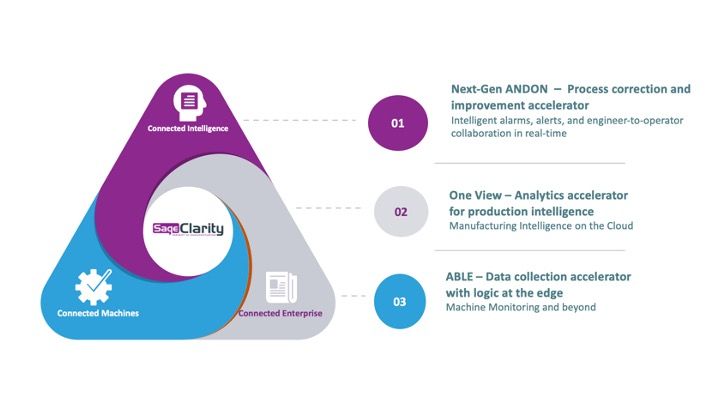
[post_title] => Sage Clarity’s Digital Transformation Accelerator Apps (Insight) [post_excerpt] => [post_status] => publish [comment_status] => open [ping_status] => open [post_password] => [post_name] => accelerator-apps-insight [to_ping] => [pinged] => [post_modified] => 2023-07-20 12:44:32 [post_modified_gmt] => 2023-07-20 16:44:32 [post_content_filtered] => [post_parent] => 0 [guid] => https://tech-clarity.com/?p=18462 [menu_order] => 0 [post_type] => post [post_mime_type] => [comment_count] => 0 [filter] => raw ) [12] => WP_Post Object ( [ID] => 18440 [post_author] => 2574 [post_date] => 2023-07-13 10:00:07 [post_date_gmt] => 2023-07-13 14:00:07 [post_content] =>
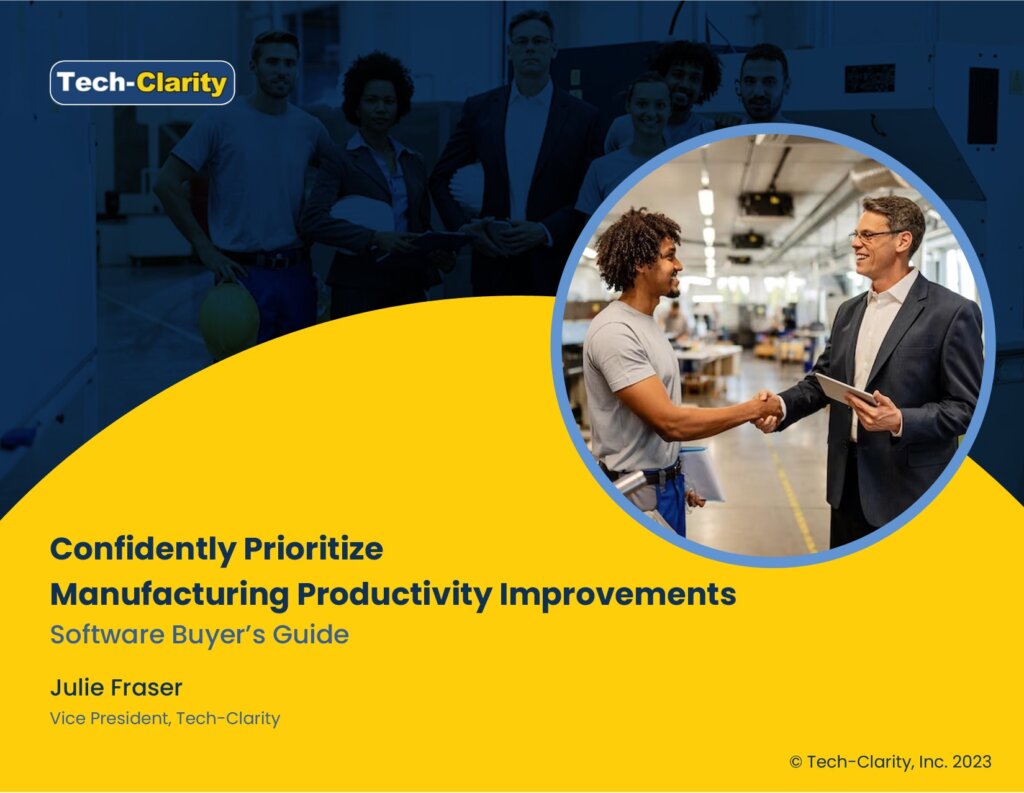 In these competitive times, continuous improvement is crucial, but it’s not always easy to pinpoint where the biggest benefits lie. How can you prioritize manufacturing improvement opportunities to ensure maximum value to the business? This Buyer’s Guide points to an array of software characteristics to support such decisions. You need digital means to support greater confidence in your decisions about which projects to fund when.
Please enjoy the summary below. For the full buyer’s guide please visit our sponsor, PTC (registration required).
For related content, A New Era of Continuous Improvement, shares results from manufacturers, consultants, and associations to validate the continuous improvement (CI) notions in the white paper; our eBook, Getting Beyond Percentages to Insights with OEE, shares insights on how your overall equipment effectiveness (OEE) metrics could accelerate improvement; and find out the difference between a typical continuous improvement program and one that's better in our Improving Continuous Improvement infographic.
In these competitive times, continuous improvement is crucial, but it’s not always easy to pinpoint where the biggest benefits lie. How can you prioritize manufacturing improvement opportunities to ensure maximum value to the business? This Buyer’s Guide points to an array of software characteristics to support such decisions. You need digital means to support greater confidence in your decisions about which projects to fund when.
Please enjoy the summary below. For the full buyer’s guide please visit our sponsor, PTC (registration required).
For related content, A New Era of Continuous Improvement, shares results from manufacturers, consultants, and associations to validate the continuous improvement (CI) notions in the white paper; our eBook, Getting Beyond Percentages to Insights with OEE, shares insights on how your overall equipment effectiveness (OEE) metrics could accelerate improvement; and find out the difference between a typical continuous improvement program and one that's better in our Improving Continuous Improvement infographic.
Table of Contents
- Evaluation Criteria
- Urgency to Improve Manufacturing Productivity
- Current Situation
- Prioritizing Manufacturing Productivity Opportunities
- Functionality for Prioritizing Opportunities
- Analytics for Clear Action
- Technology Considerations
- Evaluating Software Partners
- Implementation Factors
- Software Investment Priorities
- Maximum Value for Productivity Projects
- Recommendations
- Acknowledgments
Urgency to Improve Manufacturing Productivity
Staying Competitive Most manufacturers are in competitive markets with supply chain challenges. With so much out of the company’s control, it’s vital to leverage production resources such as facilities, equipment, people, materials, and tools effectively. Today’s environment of great uncertainty makes this more complex and crucial to success. Needs Expand with the Move to the Digital Enterprise Productivity is all about minimizing losses – and time is the obvious way to measure those losses. The impacts of lost time are not just on the production operation itself. Time losses can be quantified in terms of impact on profit and customer service. Capacity-constrained companies can sell as much as they can make, so it’s a top-line issue for revenues. For these companies, it also determines when they can promise and deliver orders to customers.Even when not capacity constrained, time losses can impact costs and customer satisfaction. In some cases, companies could lower materials, assets, energy, quality, compliance, and payroll costs. Continuous Improvement Yet, calculating where to focus to stem those time losses is not straightforward since many sources of waste contribute to throughput and productivity losses. Continuous Improvement (CI) is a common process manufacturers use to identify and eliminate waste to improve performance. It may be called Lean, Six Sigma, Operational Excellence, or other names. In these trying times, CI programs can feed success – particularly if they have balanced characteristics and digital support.Prioritizing Manufacturing Productivity Opportunities
Helping Focus As the term prioritizing suggests, what is new here is that the software is not just measuring performance but ranking opportunities for improvement. By seeking prioritization, you get support to focus resources and attention, which can be challenging with traditional manufacturing intelligence, OEE, or dashboard software. Readying for Action In addition to prioritizing opportunities, seek out software that provides a reason drill-down for each problem. This ability to deliver deeper insights into root causes can transform challenges into opportunities One Application, Many Roles Seek a software system that can support multiple user profiles:- Executives and Managers for comparing plants, products, and investment in CI programs
- CI leads for plotting priorities and tracking progress
- Supervisors for focusing on how to improve in their area
- Operators and Technicians to focus, buy in, and see what’s working and how much time they can save
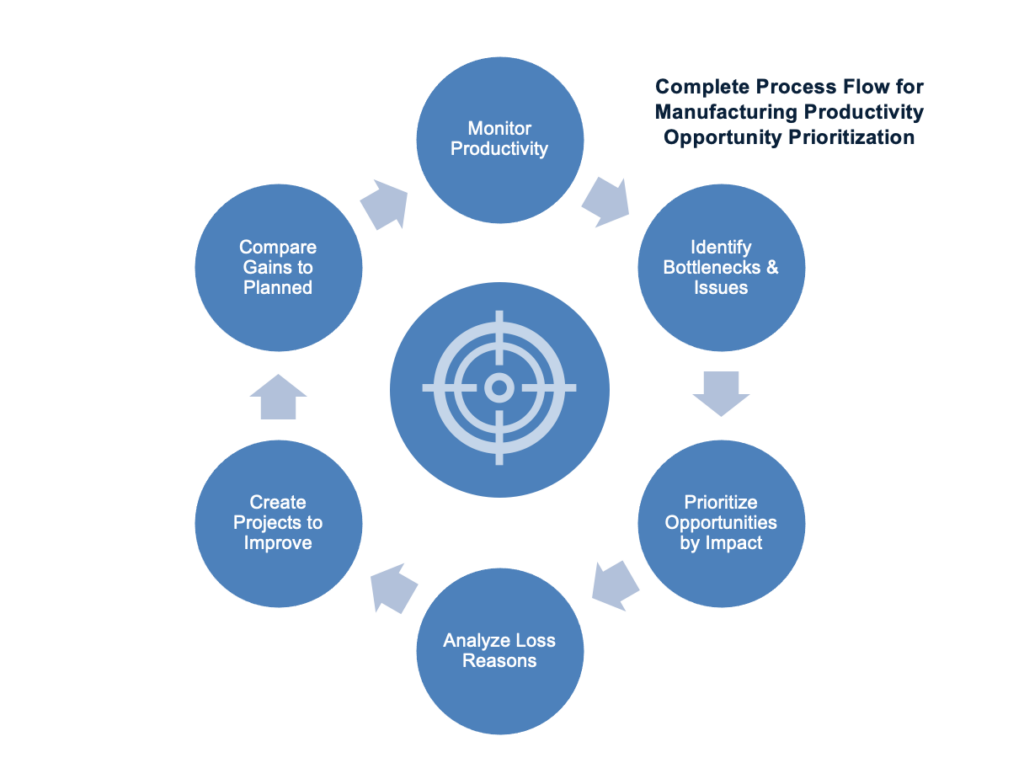 This summary is an abbreviated version of the research and does not contain the full content. For the full research, please visit our sponsor PTC (registration required).
If you have difficulty obtaining a copy of the report, please contact us.
[post_title] => Confidently Prioritize Manufacturing Improvement Opportunities
[post_excerpt] =>
[post_status] => publish
[comment_status] => open
[ping_status] => open
[post_password] =>
[post_name] => prioritize-manufacturing-improvement
[to_ping] =>
[pinged] =>
[post_modified] => 2024-05-01 13:28:52
[post_modified_gmt] => 2024-05-01 17:28:52
[post_content_filtered] =>
[post_parent] => 0
[guid] => https://tech-clarity.com/?p=18440
[menu_order] => 0
[post_type] => post
[post_mime_type] =>
[comment_count] => 0
[filter] => raw
)
[13] => WP_Post Object
(
[ID] => 18421
[post_author] => 2574
[post_date] => 2023-07-11 10:00:11
[post_date_gmt] => 2023-07-11 14:00:11
[post_content] =>
This summary is an abbreviated version of the research and does not contain the full content. For the full research, please visit our sponsor PTC (registration required).
If you have difficulty obtaining a copy of the report, please contact us.
[post_title] => Confidently Prioritize Manufacturing Improvement Opportunities
[post_excerpt] =>
[post_status] => publish
[comment_status] => open
[ping_status] => open
[post_password] =>
[post_name] => prioritize-manufacturing-improvement
[to_ping] =>
[pinged] =>
[post_modified] => 2024-05-01 13:28:52
[post_modified_gmt] => 2024-05-01 17:28:52
[post_content_filtered] =>
[post_parent] => 0
[guid] => https://tech-clarity.com/?p=18440
[menu_order] => 0
[post_type] => post
[post_mime_type] =>
[comment_count] => 0
[filter] => raw
)
[13] => WP_Post Object
(
[ID] => 18421
[post_author] => 2574
[post_date] => 2023-07-11 10:00:11
[post_date_gmt] => 2023-07-11 14:00:11
[post_content] => 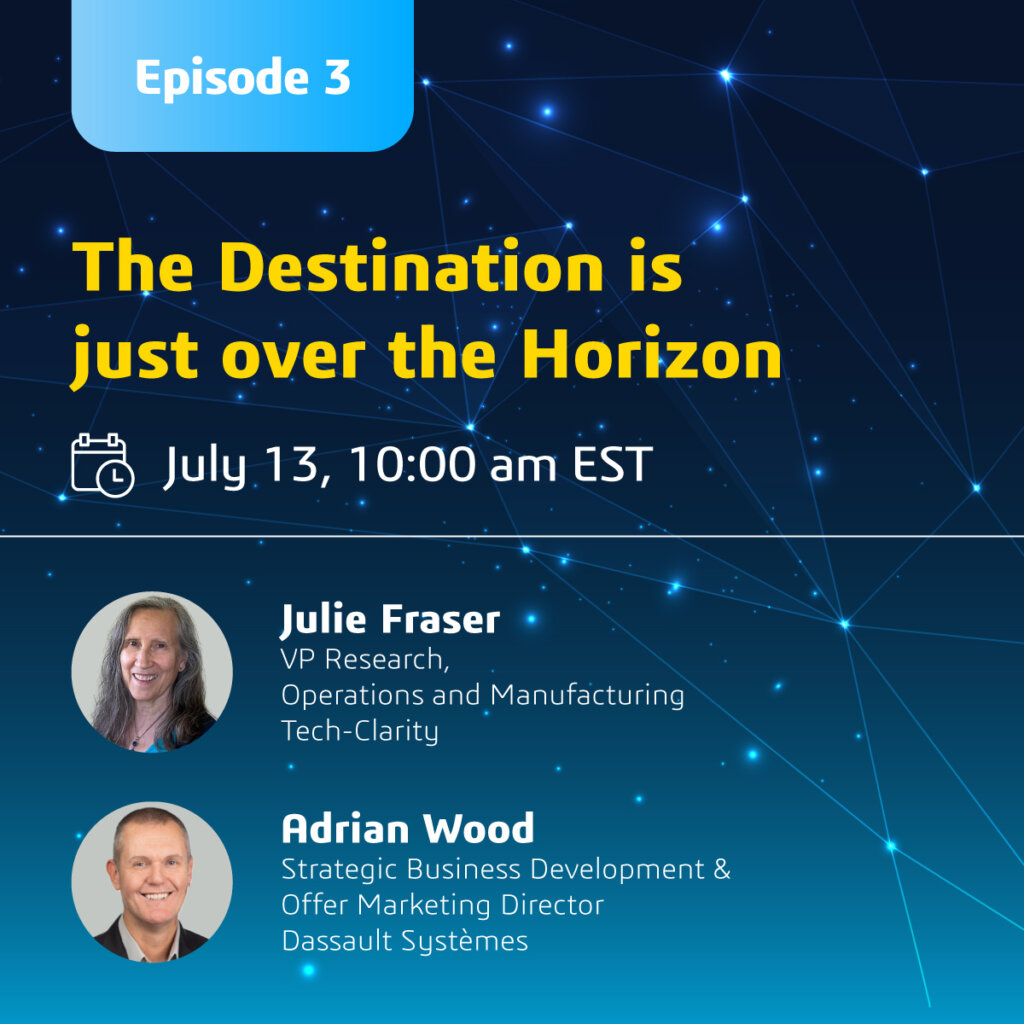 What most contributes to a supply chain having a positive impact on the business? Which disciplines and data sets make the most difference in supply chain resilience? Learn what Top Performers have to say about these that’s different. Julie Fraser, Tech-Clarity’s VP of Research for Operations and Manufacturing, will discuss initial findings of a soon-to-be released survey of 229 industry professionals. We will discuss supply chain findings including:
What most contributes to a supply chain having a positive impact on the business? Which disciplines and data sets make the most difference in supply chain resilience? Learn what Top Performers have to say about these that’s different. Julie Fraser, Tech-Clarity’s VP of Research for Operations and Manufacturing, will discuss initial findings of a soon-to-be released survey of 229 industry professionals. We will discuss supply chain findings including:
- Top supply chain challenges
- What Top Performers see as the top factor enabling their supply chain to have a positive impact on the business
- Where Top Performers have visibility others may not have consistently
- Which data and disciplines Top Performers are more likely to have than Others
- Which types of Digital Twins should be part of an ideal planning solution
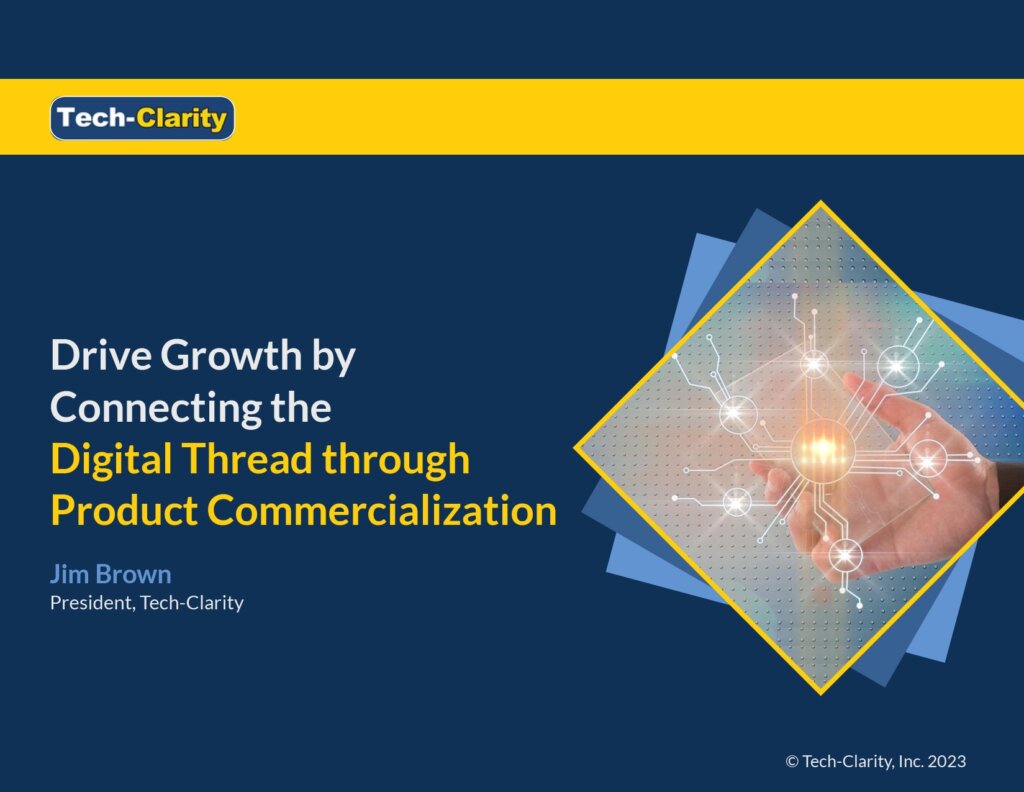 How can companies leverage the digital thread to grow their top line and market share through better customer experiences? Our new eBook teaches companies how to adapt people, processes, and technology to improve revenue and customer experiences by connecting the product digital thread from design through product commercialization.
Please enjoy the summary* below. For the full research, please visit our sponsor Propel (registration required).
To learn how extending the digital thread into the customer experience can help, please read our earlier eBook: Extending Digital Threads to the Customer Experience.
How can companies leverage the digital thread to grow their top line and market share through better customer experiences? Our new eBook teaches companies how to adapt people, processes, and technology to improve revenue and customer experiences by connecting the product digital thread from design through product commercialization.
Please enjoy the summary* below. For the full research, please visit our sponsor Propel (registration required).
To learn how extending the digital thread into the customer experience can help, please read our earlier eBook: Extending Digital Threads to the Customer Experience.
Table of Contents
- Recognize the Downside of Disconnects
- Connect the Product Digital Thread through Commercialization
- The Two Primary Values of the Digital Thread
- Extend the Digital Thread through Commercialization
- Connect People
- Connect Processes
- Connect Technology
- Recommendations and Next Steps
- Acknowledgments
Grow Revenue with Better Customer Experience
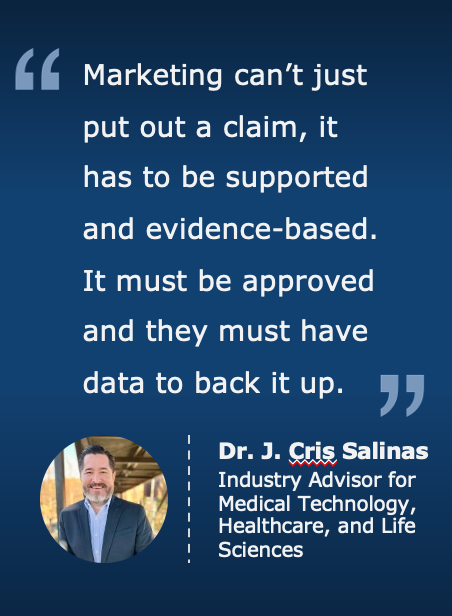 Provide Consistent, Compelling Product Experience
One way to improve customer experiences, and business performance, is by feeding compelling, accurate, and consistent product experiences across channels to entice customers and influence their buying decisions. It’s important to recognize, however, that the job doesn’t end there. Experiences can’t be static. They have to evolve as products, messaging, customer needs, channels, and markets change and expand.
Digitally Transform the Product Experience Pipeline
Conveying consistent product experiences relies on speed and accuracy. Today’s processes, however, are typically manual, slow, disconnected, and error-prone. To drive growth, companies need reliable, trusted information as soon as it is available. It’s time to digitally transform the product information pipeline. Without this, companies can’t be fast and accurate enough to create compelling customer experiences that drive growth across channels and the product lifecycle.
Provide Consistent, Compelling Product Experience
One way to improve customer experiences, and business performance, is by feeding compelling, accurate, and consistent product experiences across channels to entice customers and influence their buying decisions. It’s important to recognize, however, that the job doesn’t end there. Experiences can’t be static. They have to evolve as products, messaging, customer needs, channels, and markets change and expand.
Digitally Transform the Product Experience Pipeline
Conveying consistent product experiences relies on speed and accuracy. Today’s processes, however, are typically manual, slow, disconnected, and error-prone. To drive growth, companies need reliable, trusted information as soon as it is available. It’s time to digitally transform the product information pipeline. Without this, companies can’t be fast and accurate enough to create compelling customer experiences that drive growth across channels and the product lifecycle.
Extend the Digital Thread through Commercialization
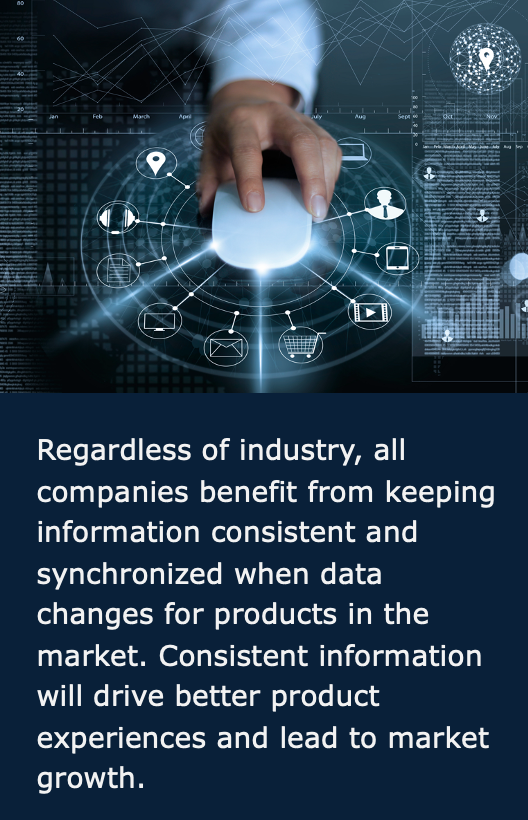 Understand the Need / Priority
Most people recognize that designing a great product is only half of the job. They have to effectively bring them to market. Beyond the initial introduction, they also need to support channel growth. Ember Technologies, Inc. is a global company whose mission is to harness the power of temperature control to transform how the world eats, drinks and lives. “Ember started out strictly eCommerce, then added Amazon, before growing into a large retail business,” says Ember’s Siobhan Hunter. Rapid growth adds effort and complexity because companies with a trajectory like Ember must continue to provide consistent product experiences even as they expand to broader channels.
Recognize Broad Applicability
Consumer goods companies like Ember are more likely to have cross-departmental processes defined to link product design with commercialization. But even these companies typically have room for improvement. The evolution of the digital thread, however, applies to virtually every industry and channel. For example:
Understand the Need / Priority
Most people recognize that designing a great product is only half of the job. They have to effectively bring them to market. Beyond the initial introduction, they also need to support channel growth. Ember Technologies, Inc. is a global company whose mission is to harness the power of temperature control to transform how the world eats, drinks and lives. “Ember started out strictly eCommerce, then added Amazon, before growing into a large retail business,” says Ember’s Siobhan Hunter. Rapid growth adds effort and complexity because companies with a trajectory like Ember must continue to provide consistent product experiences even as they expand to broader channels.
Recognize Broad Applicability
Consumer goods companies like Ember are more likely to have cross-departmental processes defined to link product design with commercialization. But even these companies typically have room for improvement. The evolution of the digital thread, however, applies to virtually every industry and channel. For example:
- Business to Consumer (B2C) companies can quickly get consistent, accurate, and compelling information into their channels
- Business to Business (B2B) companies can get the right specifications and information for their datasheets, spec sheets, website, distributors, catalogs, portals, and customers
- Regulated industries can ensure information is accurate and auditable in a trusted source for improved control and traceability
Recommendations and Next Steps
Recognize the Urgency It’s time to recognize the value and the need to change how product experiences and product information flows through the organization. Companies that want to outpace the market, grow faster, drive revenue, reach customers sooner, and create better experiences should extend their digital thread from design through commercialization. Companies that adopt this approach will be able to:- Improve time to market
- Bring continuity, timeliness, and quality to product data
- Build customer loyalty and brand trust
- Give marketing and commercialization teams the information they need, when they need it, in a way they trust
- Allow marketers to enrich, structure, and organize product data for the buyer
- Allow them to put forward a consistent, compelling product experience to customers, regardless of the channel or platform they interact with it
- Connect people across the product digital thread
- Develop cross-departmental processes from design through commercialization
- Integrate technology, or find a solution that prioritizes integration in the places that add the most value to your business
- SaaS Strategy
- Support for Software/Smart Products
- Extending Field Service Capabilities
- Design for Sustainability
1. SaaS Strategy
Most significant was PTC's strengthened SaaS strategy with the acquisitions of cloud-native Onshape and Arena for product design (CAD and CAE/Simulation), product data management (PDM), and product lifecycle management (PLM). These products make up its Velocity Group. PTC then created its Altas SaaS platform based on Onshape technology. This platform was used to create SaaS offerings for its existing products. They designate their SaaS offerings as "+," meaning the current offering, "plus more," with added cloud capabilities. These capabilities include real-time collaboration, faster deployment, reduced hardware costs, and easier methods for the broader enterprise to access product information. PTC previously launched Windchill+, Kepware +, and Vfuria+. The newest addition, Creo+, was announced at LiveWorx 2023. Brian Thompson explained that Creo+ offers all the capabilities of Creo 10 (also announced at LiveWorx 2023), but with new cloud-based tools. Creo+ enables real-time collaboration so internal and external team members can simultaneously work on the same design. While an exciting development, does PTC need two cloud-based solutions with Onshape/Arena and Creo+ / Windchill+? How should customers determine which is best for them? I liked how Jim Heppleman positioned this during a Q&A session. He explained that customers can decide between two product development priorities, and select the solution that best matches their needs. The priorities are: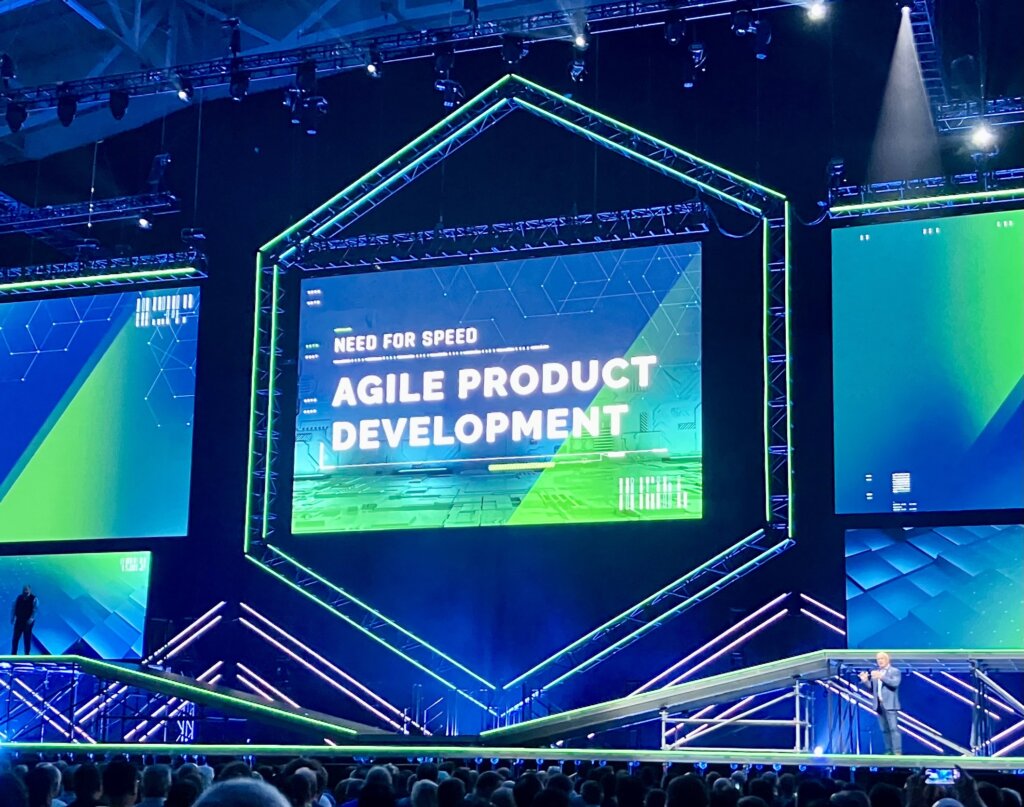 Agile Product Development: This approach applies the Agile methodologies that have been successful in software development to the entire product. Agile focuses on customer needs and providing value quickly. Work is completed in short intervals, or sprints, typically two weeks long, and validated along the way. The goal is to have a workable, high-quality product in less time. In contrast, the traditional Waterfall method waits until development work is complete before testing. Typically, teams then spend months fixing problems. An Agile approach could be particularly valuable for companies looking for high growth. For these customers, PTC suggests Onshape and Arena and David Katzman explained how these solutions support an Agile methodology.
Agile Product Development: This approach applies the Agile methodologies that have been successful in software development to the entire product. Agile focuses on customer needs and providing value quickly. Work is completed in short intervals, or sprints, typically two weeks long, and validated along the way. The goal is to have a workable, high-quality product in less time. In contrast, the traditional Waterfall method waits until development work is complete before testing. Typically, teams then spend months fixing problems. An Agile approach could be particularly valuable for companies looking for high growth. For these customers, PTC suggests Onshape and Arena and David Katzman explained how these solutions support an Agile methodology. Model-Based Digital Thread: With this approach, companies need the digital thread across the lifecycle. This supports traceability, reuse, efficiency, and a more disciplined approach. For companies that value this and profitability over growth, PTC recommends Creo and Windchill. PTC also reassures customers that all Creo data is upward compatible with Creo+.
Model-Based Digital Thread: With this approach, companies need the digital thread across the lifecycle. This supports traceability, reuse, efficiency, and a more disciplined approach. For companies that value this and profitability over growth, PTC recommends Creo and Windchill. PTC also reassures customers that all Creo data is upward compatible with Creo+.
2. Support for Software/Smart Products
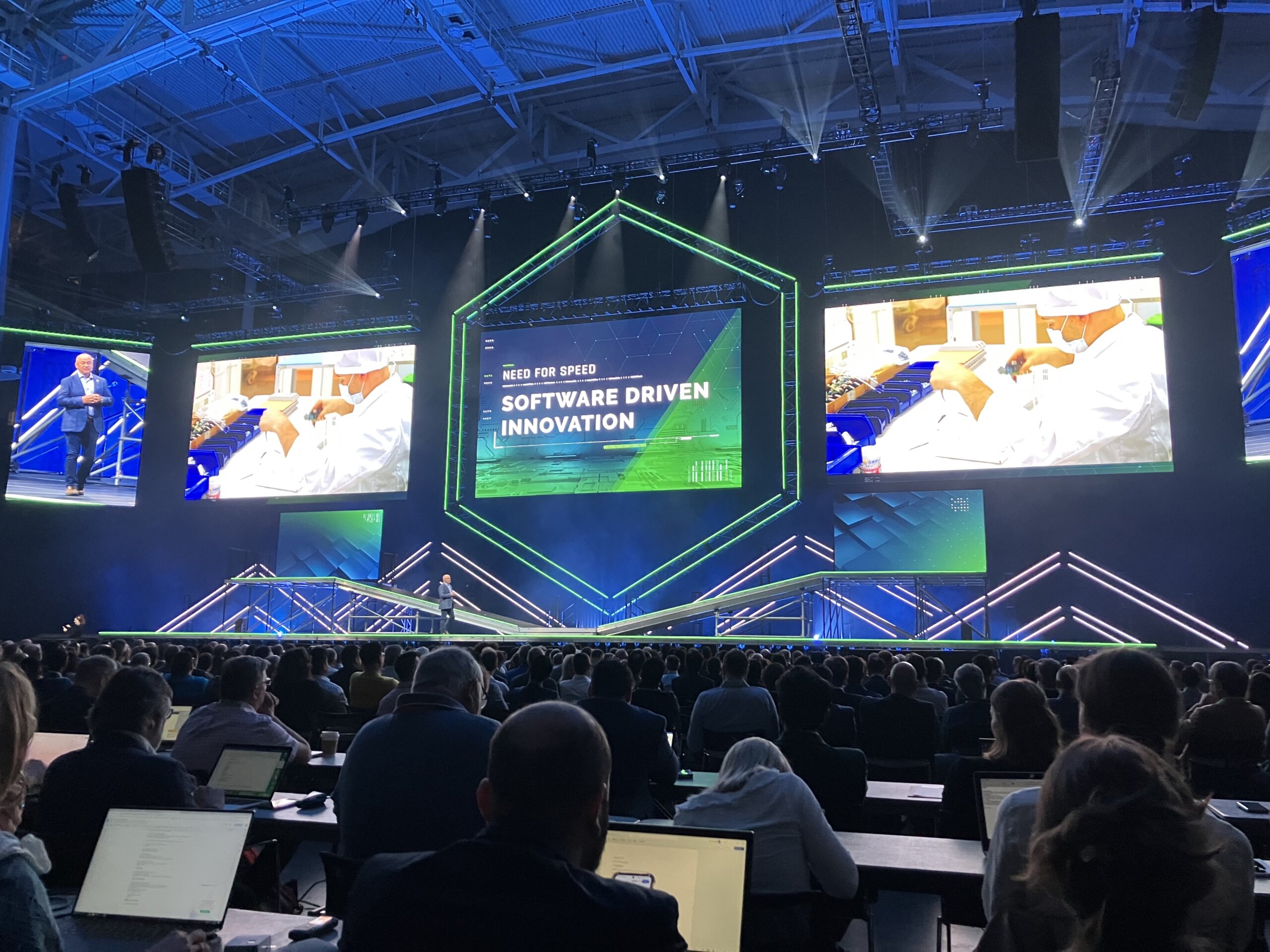 Smart products have become increasingly critical to product success. In fact, Tech-Clarity's Profiting from Smart Products found that 86% of survey respondents indicated that smart products are important for their company's long-term success and profitability. PTC already supports this with PTC Integrity for Application Lifecycle Management (ALM), including Model-Based Systems Engineering (MBSE). However, with the acquisition of Codebeamer, PTC expands their solution to support software development for manufactured products with a cloud-ready solution. With software continuing to be a major innovation driver for today's modern products, this remains an important area for a complete product development solution.
Smart products have become increasingly critical to product success. In fact, Tech-Clarity's Profiting from Smart Products found that 86% of survey respondents indicated that smart products are important for their company's long-term success and profitability. PTC already supports this with PTC Integrity for Application Lifecycle Management (ALM), including Model-Based Systems Engineering (MBSE). However, with the acquisition of Codebeamer, PTC expands their solution to support software development for manufactured products with a cloud-ready solution. With software continuing to be a major innovation driver for today's modern products, this remains an important area for a complete product development solution.
3. Extending Field Service Capabilities
 PTC has several offerings to support product service, including PTC Arbortext for technical publications and service manuals, Servigistics for optimized spare parts management, and Vuforia. for 3D work instructions and augmented reality. PTC significantly expanded this portfolio by acquiring ServiceMax, the largest acquisition in its history. Neil Barua explained that ServiceMax supports field service operations. It keeps a record of prior issues, previous maintenance, and part replacements. The offering is further strengthened with ThingWorx to monitor the product fleet for more predictive and preventative maintenance.
PTC has several offerings to support product service, including PTC Arbortext for technical publications and service manuals, Servigistics for optimized spare parts management, and Vuforia. for 3D work instructions and augmented reality. PTC significantly expanded this portfolio by acquiring ServiceMax, the largest acquisition in its history. Neil Barua explained that ServiceMax supports field service operations. It keeps a record of prior issues, previous maintenance, and part replacements. The offering is further strengthened with ThingWorx to monitor the product fleet for more predictive and preventative maintenance.
4. Design for Sustainability
Finally, EVP Chief Strategy & Sustainability Officer, Catherine Kniker (CK) stressed the importance of sustainability considerations during design, emphasizing that design decisions determine 80% of a product's environmental footprint. Engineers can improve sustainability by evaluating materials, energy efficiency, and waste reduction. PTC plans to support some of these decisions through expanded partnerships with Ansys and aPriori Technologies. Integrated workflows with Ansys Granta, a Materials Information Management solution (Ansys Materials), Creo, and Windchill, will allow engineers to assess the impact of different materials on performance, recyclability, and carbon footprint. Ansys CEO Ajei Gopal also joined Jim Hepplemann on stage to discuss the strength of their partnership in other ways to support for digital transformation and simulation-driven design with continued and tighter integrations across products lines including Windchill and Ansys Minerva.
PTC and aPriori are also planning for greater interoperability between aPriori, Creo, and Windchill so that engineers can leverage aPriori to assess cost, manufacturability, and sustainability. Engineers will be able to understand their impact on the manufacturing footprint and cost as the design evolves. aPriori's software will also make improvement recommendations.
Beyond these expanded partnerships, PTC signed the Science Based Targets initiative (SBTi) commitment letter, pledging to reduce near-term emissions reductions and meet long-term net-zero targets.
We look forward to hearing how these investments offer PTC customers even more value. Thanks to Coray Thibaut de Maisieres, and Ernestine Tiongson for hosting us at PTC LiveWorx 2023.
[post_title] => PTC LiveWorx 2023
[post_excerpt] =>
[post_status] => publish
[comment_status] => open
[ping_status] => open
[post_password] =>
[post_name] => ptc-liveworx-2023
[to_ping] =>
[pinged] =>
[post_modified] => 2023-12-15 12:53:21
[post_modified_gmt] => 2023-12-15 17:53:21
[post_content_filtered] =>
[post_parent] => 0
[guid] => https://tech-clarity.com/?p=18366
[menu_order] => 0
[post_type] => post
[post_mime_type] =>
[comment_count] => 0
[filter] => raw
)
[16] => WP_Post Object
(
[ID] => 18334
[post_author] => 2
[post_date] => 2023-06-13 09:00:09
[post_date_gmt] => 2023-06-13 13:00:09
[post_content] =>
Integrated workflows with Ansys Granta, a Materials Information Management solution (Ansys Materials), Creo, and Windchill, will allow engineers to assess the impact of different materials on performance, recyclability, and carbon footprint. Ansys CEO Ajei Gopal also joined Jim Hepplemann on stage to discuss the strength of their partnership in other ways to support for digital transformation and simulation-driven design with continued and tighter integrations across products lines including Windchill and Ansys Minerva.
PTC and aPriori are also planning for greater interoperability between aPriori, Creo, and Windchill so that engineers can leverage aPriori to assess cost, manufacturability, and sustainability. Engineers will be able to understand their impact on the manufacturing footprint and cost as the design evolves. aPriori's software will also make improvement recommendations.
Beyond these expanded partnerships, PTC signed the Science Based Targets initiative (SBTi) commitment letter, pledging to reduce near-term emissions reductions and meet long-term net-zero targets.
We look forward to hearing how these investments offer PTC customers even more value. Thanks to Coray Thibaut de Maisieres, and Ernestine Tiongson for hosting us at PTC LiveWorx 2023.
[post_title] => PTC LiveWorx 2023
[post_excerpt] =>
[post_status] => publish
[comment_status] => open
[ping_status] => open
[post_password] =>
[post_name] => ptc-liveworx-2023
[to_ping] =>
[pinged] =>
[post_modified] => 2023-12-15 12:53:21
[post_modified_gmt] => 2023-12-15 17:53:21
[post_content_filtered] =>
[post_parent] => 0
[guid] => https://tech-clarity.com/?p=18366
[menu_order] => 0
[post_type] => post
[post_mime_type] =>
[comment_count] => 0
[filter] => raw
)
[16] => WP_Post Object
(
[ID] => 18334
[post_author] => 2
[post_date] => 2023-06-13 09:00:09
[post_date_gmt] => 2023-06-13 13:00:09
[post_content] => 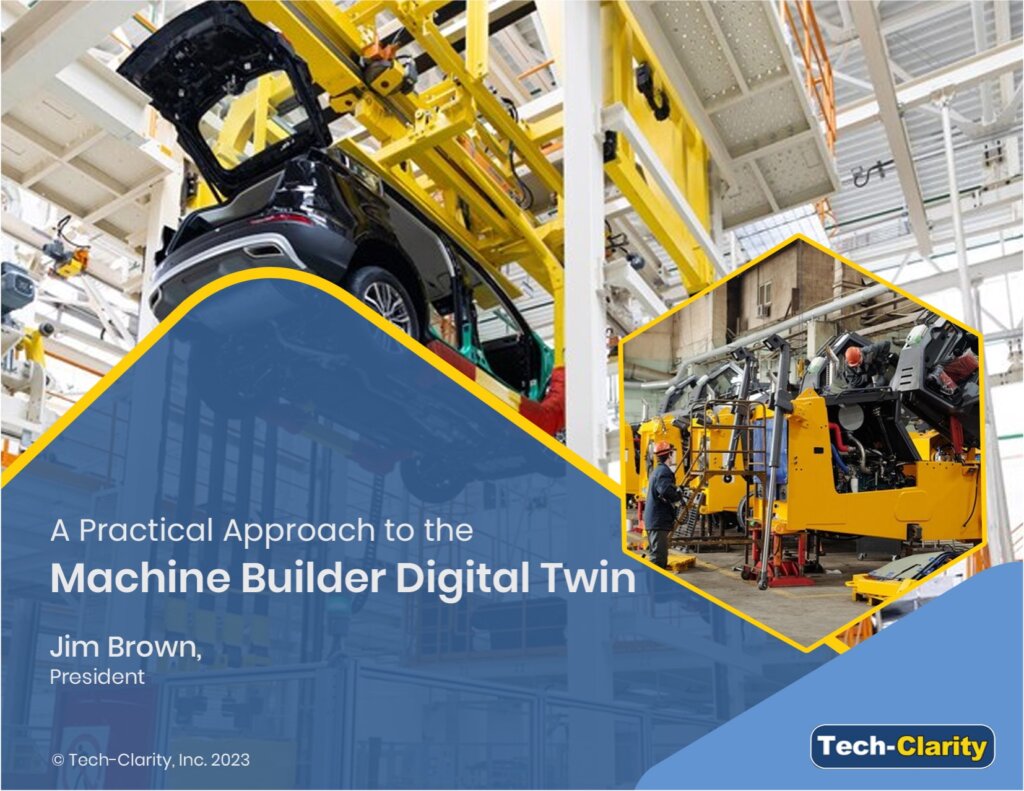 Machine builders must continuously raise the bar to compete in today's dynamic, global markets. How are they leveraging digital twins to improve how they quote, design, produce, install, and commission more complex, smart, connected, flexible, and tailored equipment than ever? Further, how can they extend their digital twins to improve installation, commissioning, and service?
Please enjoy the summary below and visit our sponsor Siemens to learn more about machine builder digital twins and other solutions for machine builders. You can also download the full eBook to learn more.
For related research, please read Increasing Equipment Design Velocity and Increasing Performance Engineering Performance.
Machine builders must continuously raise the bar to compete in today's dynamic, global markets. How are they leveraging digital twins to improve how they quote, design, produce, install, and commission more complex, smart, connected, flexible, and tailored equipment than ever? Further, how can they extend their digital twins to improve installation, commissioning, and service?
Please enjoy the summary below and visit our sponsor Siemens to learn more about machine builder digital twins and other solutions for machine builders. You can also download the full eBook to learn more.
For related research, please read Increasing Equipment Design Velocity and Increasing Performance Engineering Performance.
Table of Contents
- Recognize the Potential of the Digital Twin
- Making Progress Toward Your Digital Twin
- 1) Design in Full Product Context
- 2) Embrace BOMs / Configurations / Variability
- 3) Simulate / Optimize / Virtually Validate Equipment
- 4) Expand Further Down the Lifecycle
- Get Started
- Acknowledgments
Improving Engineering, and more, with the Digital Twin
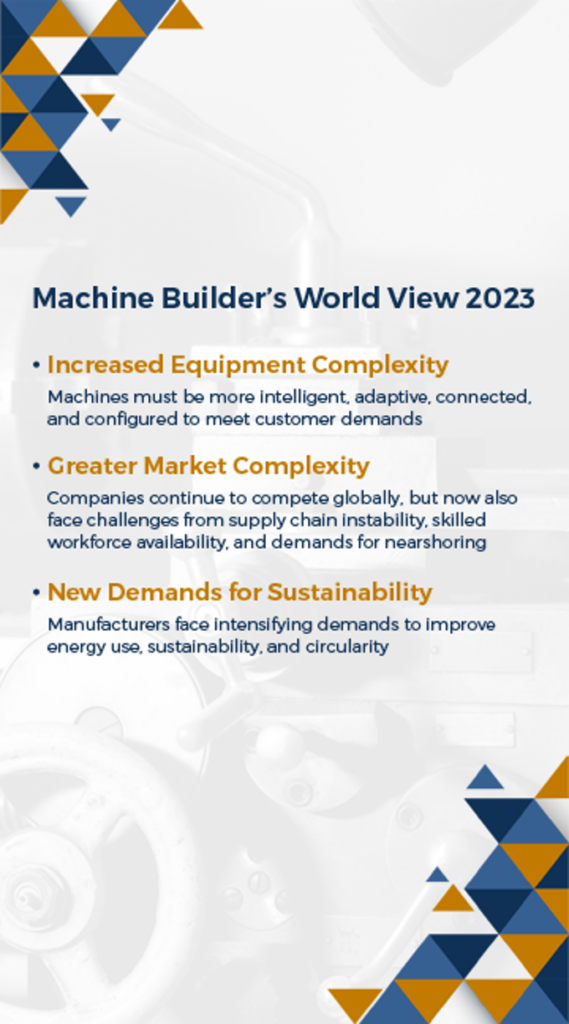 Digital Twin Potential
Machine builders must continuously raise the bar to compete in today's dynamic, global markets. How are they leveraging digital twins to improve how they quote, design, produce, install, and commission more complex, smart, connected, flexible, and tailored equipment than ever? Further, how can they extend their digital twins to improve installation, commissioning, and service
Increase Digital Twin Maturity to Drive Value
Digital twin improvement opportunities span the product lifecycle and offer significant new business value from bids through service. Our research shows that top-performing manufacturers use more advanced, mature digital twin capabilities.1 But few machine builders have tapped the full potential.
Continuous improvement through a comprehensive digital twin spanning the lifecycle is valuable, but it is a journey. There is plenty of room for most manufacturers to improve and drive increased profitability, but they can't do it all at once. Instead, they can implement the basics and find ways to expand the value through higher maturity at each step. This eBook introduces four areas where machine builders can improve their digital twins, sharing a combination of first steps and more advanced actions to drive business value and increase profitability.
Digital Twin Potential
Machine builders must continuously raise the bar to compete in today's dynamic, global markets. How are they leveraging digital twins to improve how they quote, design, produce, install, and commission more complex, smart, connected, flexible, and tailored equipment than ever? Further, how can they extend their digital twins to improve installation, commissioning, and service
Increase Digital Twin Maturity to Drive Value
Digital twin improvement opportunities span the product lifecycle and offer significant new business value from bids through service. Our research shows that top-performing manufacturers use more advanced, mature digital twin capabilities.1 But few machine builders have tapped the full potential.
Continuous improvement through a comprehensive digital twin spanning the lifecycle is valuable, but it is a journey. There is plenty of room for most manufacturers to improve and drive increased profitability, but they can't do it all at once. Instead, they can implement the basics and find ways to expand the value through higher maturity at each step. This eBook introduces four areas where machine builders can improve their digital twins, sharing a combination of first steps and more advanced actions to drive business value and increase profitability.
Recognize the Potential of the Machine Builder Digital Twin
The Growing Need for Machine Digital Twins Machine builders face increased challenges, including increased equipment complexity, greater market complexity, and new demands for sustainability. These issues impact their operations and their operators, driving additional engineering requirements such as increased machine automation, monitoring, and the need for remote service. Extend Machine Builder Digital Twin Value over the Product Lifecycle Comprehensive digital twins allow equipment manufacturers to innovate and experiment in the virtual world to get unique machines right the first time. Virtual design helps them improve machine design cycles, quality, performance, configurability, and sustainability by allowing all disciplines to collaborate starting as early as equipment requirements on a holistic, contextualized product model. Lastly, running digital twin simulations enable them to optimize designs virtually before building them. But the value doesn't end in Engineering. Machine digital twins incorporating manufacturing operations and quality data allow them to produce equipment faster and more efficiently with higher first-time quality. Machine digital twins extended to the operating environment can speed up commissioning, ensure equipment runs the first time, improve performance for machine operators, and enhance operator training. Twins can also enhance service through service transformation, including machine monitoring and analytics. Finally, they can help in product retirement by enabling circular thinking where equipment can be brought back, refurbished, or harvested for valuable components.Making Progress Toward Your Digital Twin
Choosing a Starting Point For many companies, the improvements described on the previous page sound like rocket science. In fact, it is. Industries like aerospace have proven the value, and the potential is nearly limitless. But adoption can be intimidating, especially for manufacturers that haven't fully achieved the value a holistic digital twin can offer to Engineering. What should machine builders do now? Each manufacturer needs to define what the digital twin means to their business, assess their current capabilities and then make tangible, incremental steps to improve their maturity and associated business value. Digital twin initiatives should have rapid ROIs, providing value right away and making progress toward a fully mature future state. The value will be different for each company, but we've identified a number of improvements for companies to use as a starting point based on their goals and maturity. Create a Value-Driven Strategy It's essential to develop a practical plan based on what would be the most valuable to the company. Find practical problems and use the digital twin to address them. The challenges may relate to quality, speed to market, or supporting additional configurability without compromising quality. Or, they may be supplier collaboration challenges. For some, they could be sales enablers to let potential customers experience how configured equipment will behave in their environment using high-fidelity simulations. We recognize that each company is different in their starting point, what will drive the most value, and the practical sequence in which they can implement changes. It's time to identify ways to get started, create a customized plan with first steps to drive business success, extend the value, and expand on the competitive advantages achieved. Let's look at some opportunities. Start Small, then Expand The opportunities are expansive and potentially overwhelming. Remember that every company is different in where they start and what will drive the most value. Don't try to do too much at once or skip maturity steps. Focus on the tangible steps that add value to your business. But, keep the big picture in mind to ensure that early successes can be built on to reach a higher vision. Focus on People and Process
The end goal is a better way of doing business, an integrated design and development process supported by the machine digital twin. To achieve this vision, make sure to get key people and departments aligned with the vision and the transformation. Help them understand the big picture, the steps to achieve it, and how it will help them in addition to helping the company.
Enable the Transition
New ways of working require the right tools. It's essential to evaluate your current software solution portfolio to ensure they are sufficient for the job. An effective machine digital twin requires support from a variety of engineering solutions, including CAD, multiphysics CAE, software design, and PLM. It also requires industrial and factory automation solutions, including CAM, MES, HMI, SCADA, virtual commissioning, and the IIoT. Depending on maturity, it may also require asset lifecycle and service management solutions (ALM and SLM).
Think Holistically
It's important to consider more than individual tools. Evaluating how solutions work together to support the digital thread across the lifecycle is crucial. The machine digital twin is best served by a platform of solutions that work together. The platform should provide a central data model, the digital twin backbone, kept in configured context. It should be able to be acted on from different angles so everyone can contribute and get what they need in a secure, collaborative environment. Together, these product innovation platform capabilities support the machine digital twin.
It's essential to acknowledge, though, that no single platform will support every need. It's critical that the platform is open to allow integration and offers the capability to develop new applications that pull information together for specific purposes, ideally in a no-code or low-code environment.
Let’s Get Started
There are many options and a lot to do, but the value should come fast and be extended over time. Let's get started.
[post_title] => The Machine Builder Digital Twin
[post_excerpt] =>
[post_status] => publish
[comment_status] => open
[ping_status] => open
[post_password] =>
[post_name] => machine-builder-digital-twin
[to_ping] =>
[pinged] =>
[post_modified] => 2023-12-15 15:01:36
[post_modified_gmt] => 2023-12-15 20:01:36
[post_content_filtered] =>
[post_parent] => 0
[guid] => https://tech-clarity.com/?p=18334
[menu_order] => 0
[post_type] => post
[post_mime_type] =>
[comment_count] => 0
[filter] => raw
)
[17] => WP_Post Object
(
[ID] => 18325
[post_author] => 2
[post_date] => 2023-06-08 10:00:57
[post_date_gmt] => 2023-06-08 14:00:57
[post_content] =>
Focus on People and Process
The end goal is a better way of doing business, an integrated design and development process supported by the machine digital twin. To achieve this vision, make sure to get key people and departments aligned with the vision and the transformation. Help them understand the big picture, the steps to achieve it, and how it will help them in addition to helping the company.
Enable the Transition
New ways of working require the right tools. It's essential to evaluate your current software solution portfolio to ensure they are sufficient for the job. An effective machine digital twin requires support from a variety of engineering solutions, including CAD, multiphysics CAE, software design, and PLM. It also requires industrial and factory automation solutions, including CAM, MES, HMI, SCADA, virtual commissioning, and the IIoT. Depending on maturity, it may also require asset lifecycle and service management solutions (ALM and SLM).
Think Holistically
It's important to consider more than individual tools. Evaluating how solutions work together to support the digital thread across the lifecycle is crucial. The machine digital twin is best served by a platform of solutions that work together. The platform should provide a central data model, the digital twin backbone, kept in configured context. It should be able to be acted on from different angles so everyone can contribute and get what they need in a secure, collaborative environment. Together, these product innovation platform capabilities support the machine digital twin.
It's essential to acknowledge, though, that no single platform will support every need. It's critical that the platform is open to allow integration and offers the capability to develop new applications that pull information together for specific purposes, ideally in a no-code or low-code environment.
Let’s Get Started
There are many options and a lot to do, but the value should come fast and be extended over time. Let's get started.
[post_title] => The Machine Builder Digital Twin
[post_excerpt] =>
[post_status] => publish
[comment_status] => open
[ping_status] => open
[post_password] =>
[post_name] => machine-builder-digital-twin
[to_ping] =>
[pinged] =>
[post_modified] => 2023-12-15 15:01:36
[post_modified_gmt] => 2023-12-15 20:01:36
[post_content_filtered] =>
[post_parent] => 0
[guid] => https://tech-clarity.com/?p=18334
[menu_order] => 0
[post_type] => post
[post_mime_type] =>
[comment_count] => 0
[filter] => raw
)
[17] => WP_Post Object
(
[ID] => 18325
[post_author] => 2
[post_date] => 2023-06-08 10:00:57
[post_date_gmt] => 2023-06-08 14:00:57
[post_content] => ACE is Back!
 PLM conferences are back, and it seems there’s a conference a week right now! The first one I attended this Spring was Aras’ ACE conference. This
was a special one for me because it was my first time attending in person. I was planning to attend in 2020 but it was canceled due to the pandemic, and this event marked the first in-person ACE since 2019. You could feel, and hear, the energy and excitement customers and Aras employees shared about being back in person as you walked the halls and the exhibit floor. It was a large and excited crowd of customers and partners eager to share information and experience with each other and learn from Aras.
Other than the excitement of the event and the enthusiastic customer support, there are several main things I took away from the conference:
PLM conferences are back, and it seems there’s a conference a week right now! The first one I attended this Spring was Aras’ ACE conference. This
was a special one for me because it was my first time attending in person. I was planning to attend in 2020 but it was canceled due to the pandemic, and this event marked the first in-person ACE since 2019. You could feel, and hear, the energy and excitement customers and Aras employees shared about being back in person as you walked the halls and the exhibit floor. It was a large and excited crowd of customers and partners eager to share information and experience with each other and learn from Aras.
Other than the excitement of the event and the enthusiastic customer support, there are several main things I took away from the conference:
- First, a confirmation about how different the Aras Innovator offering is
- Second, how that impacts the way Aras partners with others
- Third, that Aras Innovator can compete on the strengths of their solution capabilities even without the “Aras difference”
- Aras and Microsoft announced that Aras Enterprise SaaS is now available in the Azure Marketplace, allowing Azure customers to use their Microsoft Azure contract (MAC) credits gain to access Aras’ cloud-based PLM
- CTO Rob McAveney shared that Aras is not resting on their current platform advantage, but working on “next-gen low-code” that they will deliver over the coming years
- Aras’ Alan Mendel highlighted their efforts to help manufacturers achieve sustainability needs by leveraging a variety of Aras Innovator capabilities, this appears to be an important initiative for Aras
 [post_title] => Aras Showcases Differentiation and Strengths at ACE 2023 (Insight)
[post_excerpt] =>
[post_status] => publish
[comment_status] => open
[ping_status] => open
[post_password] =>
[post_name] => aras-insight-ace-2023
[to_ping] =>
[pinged] =>
[post_modified] => 2023-12-14 14:23:26
[post_modified_gmt] => 2023-12-14 19:23:26
[post_content_filtered] =>
[post_parent] => 0
[guid] => https://tech-clarity.com/?p=18325
[menu_order] => 0
[post_type] => post
[post_mime_type] =>
[comment_count] => 0
[filter] => raw
)
[18] => WP_Post Object
(
[ID] => 18300
[post_author] => 2574
[post_date] => 2023-06-06 09:30:22
[post_date_gmt] => 2023-06-06 13:30:22
[post_content] => I feel rejuvenated after a briefing with Apprentice. Their Tempo suite is a fresh approach that marries the latest enterprise mobile and SaaS technologies with composable applications for pressing industry issues. Yes, there’s a SaaS MES – but there is more for the plant, quality lab, enterprise, and manufacturing network. It serves the product lifecycle, starting with preclinical and clinical.
The company came into being in 2014. The founders saw the industry move toward large molecule and personalized products, and they predicted the resulting radical changes in the structure of the industry. They believed older software could not support production needs such as faster changes, higher mix, continuous processes, demanding processes to grow and culture biologics, and tight collaboration with contract manufacturers. So they leveraged the most modern B2B SaaS technologies to develop the GMP-compliant Tempo Manufacturing Cloud.
The latest addition to the Tempo suite is Connected Manufacturing Network, to connect internal and external sites and teams. Capabilities include product lifecycle, enterprise recipe management, external manufacturing collaboration, and streamlined tech transfer. This real-time data-sharing capability could revolutionize how biopharma companies manage global and CMO operations.
The Tempo product line started with Tandem Virtual Collaboration, a connected worker platform with headset. Augmented Work Instructions for EBR, Procedures management, line clearance, training, and an electronic logbook came from that foundation. MES includes built-in quality, no-code procedure and recipe authoring, and enforcement. LES for the quality lab leverages some of the strengths of the MES but tailored for scientific testing and managing samples, materials, and equipment.
Apprentice.io has been growing rapidly for the past five years and has just raised another VC round to keep that momentum going. Like the company itself, their team of VCs includes both traditional high tech and life-science-focused investment companies.
I now understand how a company less than a decade old got on the Gartner Magic Quadrant for the second year in a row and moved into the visionary quadrant. The time appears to be right to infuse the most modern B2B software capabilities into the biopharma production process.
Thank you, Kristen Kucks and Marie Forshaw, for taking the time to get me up to speed!
[post_title] => Aras Showcases Differentiation and Strengths at ACE 2023 (Insight)
[post_excerpt] =>
[post_status] => publish
[comment_status] => open
[ping_status] => open
[post_password] =>
[post_name] => aras-insight-ace-2023
[to_ping] =>
[pinged] =>
[post_modified] => 2023-12-14 14:23:26
[post_modified_gmt] => 2023-12-14 19:23:26
[post_content_filtered] =>
[post_parent] => 0
[guid] => https://tech-clarity.com/?p=18325
[menu_order] => 0
[post_type] => post
[post_mime_type] =>
[comment_count] => 0
[filter] => raw
)
[18] => WP_Post Object
(
[ID] => 18300
[post_author] => 2574
[post_date] => 2023-06-06 09:30:22
[post_date_gmt] => 2023-06-06 13:30:22
[post_content] => I feel rejuvenated after a briefing with Apprentice. Their Tempo suite is a fresh approach that marries the latest enterprise mobile and SaaS technologies with composable applications for pressing industry issues. Yes, there’s a SaaS MES – but there is more for the plant, quality lab, enterprise, and manufacturing network. It serves the product lifecycle, starting with preclinical and clinical.
The company came into being in 2014. The founders saw the industry move toward large molecule and personalized products, and they predicted the resulting radical changes in the structure of the industry. They believed older software could not support production needs such as faster changes, higher mix, continuous processes, demanding processes to grow and culture biologics, and tight collaboration with contract manufacturers. So they leveraged the most modern B2B SaaS technologies to develop the GMP-compliant Tempo Manufacturing Cloud.
The latest addition to the Tempo suite is Connected Manufacturing Network, to connect internal and external sites and teams. Capabilities include product lifecycle, enterprise recipe management, external manufacturing collaboration, and streamlined tech transfer. This real-time data-sharing capability could revolutionize how biopharma companies manage global and CMO operations.
The Tempo product line started with Tandem Virtual Collaboration, a connected worker platform with headset. Augmented Work Instructions for EBR, Procedures management, line clearance, training, and an electronic logbook came from that foundation. MES includes built-in quality, no-code procedure and recipe authoring, and enforcement. LES for the quality lab leverages some of the strengths of the MES but tailored for scientific testing and managing samples, materials, and equipment.
Apprentice.io has been growing rapidly for the past five years and has just raised another VC round to keep that momentum going. Like the company itself, their team of VCs includes both traditional high tech and life-science-focused investment companies.
I now understand how a company less than a decade old got on the Gartner Magic Quadrant for the second year in a row and moved into the visionary quadrant. The time appears to be right to infuse the most modern B2B software capabilities into the biopharma production process.
Thank you, Kristen Kucks and Marie Forshaw, for taking the time to get me up to speed!
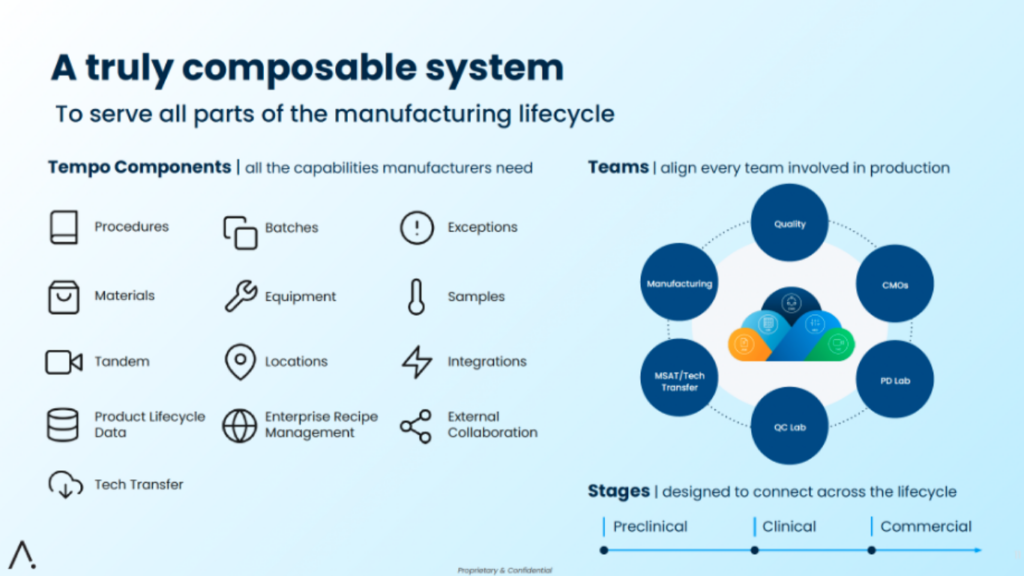
[post_title] => Apprentice.io Grows with Biopharma 4.0 SaaS Software (Insight) [post_excerpt] => [post_status] => publish [comment_status] => open [ping_status] => open [post_password] => [post_name] => biopharma-saas-software-insight [to_ping] => [pinged] => [post_modified] => 2023-08-31 17:01:09 [post_modified_gmt] => 2023-08-31 21:01:09 [post_content_filtered] => [post_parent] => 0 [guid] => https://tech-clarity.com/?p=18300 [menu_order] => 0 [post_type] => post [post_mime_type] => [comment_count] => 0 [filter] => raw ) [19] => WP_Post Object ( [ID] => 18306 [post_author] => 2574 [post_date] => 2023-06-05 23:07:10 [post_date_gmt] => 2023-06-06 03:07:10 [post_content] =>
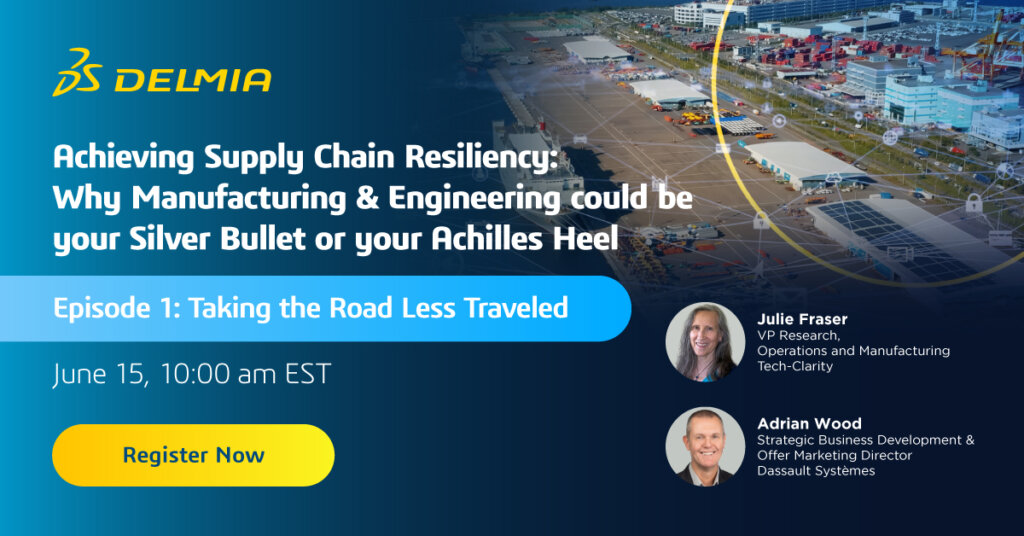 What most contributes to supply chain resiliency? What are the challenges and impacts of doing it well? Can better collaboration, cadence, or technology improve manufacturers' capability to respond to disruptions? What does it take to recover with operational continuity and minimal negative impact? What is the role of departments beyond Supply Chain?
Tech-Clarity is conducting research on these topics right now. Julie Fraser, Tech-Clarity’s VP of Research for Operations and Manufacturing, will discuss what questions are included and why. We will explore these topics:
What most contributes to supply chain resiliency? What are the challenges and impacts of doing it well? Can better collaboration, cadence, or technology improve manufacturers' capability to respond to disruptions? What does it take to recover with operational continuity and minimal negative impact? What is the role of departments beyond Supply Chain?
Tech-Clarity is conducting research on these topics right now. Julie Fraser, Tech-Clarity’s VP of Research for Operations and Manufacturing, will discuss what questions are included and why. We will explore these topics:
- Supply chain challenges and impacts in these disrupted times
- Drivers, benefits, and goals for investing in resilience
- The impact of having established and effective planning at various cadences
- The role of visibility to production capabilities and product changes in resilience
- Integration of varied disciplines and technologies to support resilience
 [post_title] => Supply Chain Resiliency: Taking the Road Less Traveled
[post_excerpt] =>
[post_status] => publish
[comment_status] => open
[ping_status] => open
[post_password] =>
[post_name] => supply-chain-resiliency-webcast
[to_ping] =>
[pinged] =>
[post_modified] => 2023-12-27 14:51:03
[post_modified_gmt] => 2023-12-27 19:51:03
[post_content_filtered] =>
[post_parent] => 0
[guid] => https://tech-clarity.com/?p=18306
[menu_order] => 0
[post_type] => post
[post_mime_type] =>
[comment_count] => 0
[filter] => raw
)
)
[post_count] => 20
[current_post] => -1
[before_loop] => 1
[in_the_loop] =>
[post] => WP_Post Object
(
[ID] => 18656
[post_author] => 2
[post_date] => 2023-09-20 09:00:05
[post_date_gmt] => 2023-09-20 13:00:05
[post_content] =>
[post_title] => Supply Chain Resiliency: Taking the Road Less Traveled
[post_excerpt] =>
[post_status] => publish
[comment_status] => open
[ping_status] => open
[post_password] =>
[post_name] => supply-chain-resiliency-webcast
[to_ping] =>
[pinged] =>
[post_modified] => 2023-12-27 14:51:03
[post_modified_gmt] => 2023-12-27 19:51:03
[post_content_filtered] =>
[post_parent] => 0
[guid] => https://tech-clarity.com/?p=18306
[menu_order] => 0
[post_type] => post
[post_mime_type] =>
[comment_count] => 0
[filter] => raw
)
)
[post_count] => 20
[current_post] => -1
[before_loop] => 1
[in_the_loop] =>
[post] => WP_Post Object
(
[ID] => 18656
[post_author] => 2
[post_date] => 2023-09-20 09:00:05
[post_date_gmt] => 2023-09-20 13:00:05
[post_content] =>  How do companies prioritize the business strategies that drive their long-term success? What’s driving their strategy as they face constantly shifting global market disruptions? How do they balance initiatives like digital transformation, ESG, developing their workforce, and adopting new business models to ensure business sustainability in 2023 and beyond?
Read our 5th annual survey to see how executive strategies have changed as companies face shifting global market disruptions.
Please enjoy the summary* below. For the full research, please visit our sponsor Dassault Systèmes (registration required).
For related research, please read our prior survey results from the past five years: Strategies for Business Sustainability 2022, Business Sustainability and Transformation Strategies 2021, Business Sustainability and Survival 2020, and Executive Strategies for Long-Term Business Success 2019.
How do companies prioritize the business strategies that drive their long-term success? What’s driving their strategy as they face constantly shifting global market disruptions? How do they balance initiatives like digital transformation, ESG, developing their workforce, and adopting new business models to ensure business sustainability in 2023 and beyond?
Read our 5th annual survey to see how executive strategies have changed as companies face shifting global market disruptions.
Please enjoy the summary* below. For the full research, please visit our sponsor Dassault Systèmes (registration required).
For related research, please read our prior survey results from the past five years: Strategies for Business Sustainability 2022, Business Sustainability and Transformation Strategies 2021, Business Sustainability and Survival 2020, and Executive Strategies for Long-Term Business Success 2019.
Table of Contents
- Disruptions Vary, But Risk is Constant
- Preparing for Success
- Strategy and Initiative Drivers Have Shifted
- ESG Pressure Comes from Many Angles
- Holistic Business Sustainability
- Putting Strategy into Action
- Technology is Key to Business Sustainability
- Technology Drivers Significant Business Benefits
- Conclusions and Recommendations
- About the Research
- Acknowledgments
A Time to Create Agility and Improve Sustainability
No Major Shocks, But Risk Remains The past decade confronted businesses with a constant barrage of disruptions, including natural catastrophes and human-created disasters. Although the business environment is still turbulent, industry faced fewer significant new events since our survey in 2022. Our fifth annual survey, though, shows that risks remain. Although the percentage saying business risk and disruption has increased "significantly" dropped 27% from the prior year, about three-quarters of responding companies still say it has grown over the last five years. Despite the lack of new shocks, companies in 2023 report that they still struggle with supply chain challenges, the fallout of COVID, and the impact of armed conflict. They also face lingering economic uncertainty despite relaxing global recession fears. Moreover, while it's not new, the threat from climate change is coming to fruition, and predicted impacts appear to be ahead of schedule. In 2022, the world's oceans were the hottest in history and exceeded the 2021 recorded maximum, and experts warn that "this year's United in Science report shows climate impacts heading into uncharted territory of destruction." Events like Canada's 2023 wildfires are constant reminders of climate change impacts and are becoming more common. Time to Continue Transformation and Drive Sustainability Our surveys on long-term business success show that companies responded to prior disruptions by accelerating technology adoption to increase agility and become more resilient. Now is the time for companies to continue with digital transformation to prepare for future inevitable disruptions and continuously improve efficiency in the face of continued economic uncertainty. At the same time, they must act on sustainability initiatives that are becoming critical to both human experience and continued economic success. Given the landscape, how are companies prioritizing the essential pillars of long-term business sustainability to ensure business success in 2023 and beyond?
Strategy and Initiative Drivers Have Shifted
A Period of (Relative) Stability Responding to global disruption dropped as a strategy driver from 52% of companies in 2020 to 10% in 2023, the lowest point since COVID began impacting global markets (see next page). This is a strong indicator that disruption may have eased off, at least so far this year. Instead, companies appear to be back on track with ambitious strategies for business sustainability. Long-term growth goals are about the same and remain the most common strategy driver. Growth goals have been a constant from the beginning of this research series, and now financial market perception has grown from a low of 20% in 2020 to one-half of companies this year. ESG becomes a Larger Factor Other factors that influence corporate strategy and initiatives have shifted. Respondents now report that strategic plans are more driven by financial market perception and ESG factors. This is very different from the "survival mode" companies faced in 2020, where essential initiatives like environmental sustainability were pushed to the side. In fact, almost one-half of respondents report that government regulation drives their strategy this year, growing by 48% since 2019. We expect that these regulations are largely focused on greenhouse gas emissions and other environmental mandates. Other ESG business pressures are becoming more prevalent as well. Environmental issues were reported 83% more frequently as a strategy driver than in 2019 and have continued to climb since a low in 2020. In addition, 44% report corporate responsibility drives strategy, growing 63% since 2019, reflecting an additional ESG-related factor being considered more frequently in strategy decisions. New Focus on New Energy This year, we began tracking how the transition to new energy drives strategy and found that over one-third report it as a driver. We believe government regulation will add to existing transformation pressures such as cost and scarcity and spur more direct activity in this area. At the same time, government investment in new energy initiatives will also likely influence corporate direction. These drivers will further ESG efforts both directly and indirectly.
Technology is Key to Business Sustainability
Technology Critical to Business Success and Profitability The second factor we investigated in detail is technology. Technology plays a crucial role in supporting the pillars and driving long-term success and profitability. To demonstrate this, a full 87% percent share that technology is important to business success, and 30% say it's critical. Technology plays a crucial role in supporting each of the pillars of long-term success. About three-quarters of companies share that technology is critical or important to five of the seven pillars, and about two-thirds report it's important to the others. Reaching ESG Goals Demands Technical Support Perhaps one of the more surprising findings is technology's high importance in supporting ESG. Companies now recognize that they need to take a systematic approach to environmental sustainability. Making sustainable decisions and green reporting require a tremendous amount of data from across the business and the supply chain. Technology is vital to capturing information and reporting on sustainability, but also to developing the insights needed to improve it. ESG technology is full of innovation. From our experience, companies are not finding a single application for ESG. They are applying existing technologies to make more sustainable choices in everything from product and service innovation to business execution. Technology is Crucial to Transformation Technology is also seen as most important to digital transformation and product / service innovation and agility. Each of these is reported as "critical" by one-third of companies. The speed and scope of innovation demand a broad array of information and collaboration across disciplines. Technology Supports Business Sustainability Technology adoption continues to play a role in preparing for and responding to disruption, providing companies the agility they need to identify and react to issues. Technology alone doesn't achieve these goals, but the key finding is that modern businesses can't survive into the future without adopting technology to support them in the digital age.Conclusions and Recommendations
 Disruption is Lower, but Remain Vigilant
Risk and disruption continue to grow, but significant disruption may have leveled off (for now). Although the most common disruptions today are the supply chain and financial market, our research shows that the problems companies face vary. Businesses should anticipate ongoing disruption and the need to develop agility and resilience. Global business means companies are constantly at risk, it's simply the reality.
Take the Long View
It's essential to prepare for disruption but stay focused on long-term business needs. Company success drivers are optimistic and show a belief in the long view, including long-term profits, innovation, and transformation. Disruptions come and go. As companies mitigate risk by becoming ever more agile and responsive, they must also stay focused on the enduring fundamentals of business success, such as customer relationships and long-term profits, while digitally transforming to stay relevant for the long term. At the same time, they must also attract and develop the workforce of the future.
Stay Focused on Sustainability
Companies are taking a balanced approach and continue to focus across the pillars of business sustainability. But the world has changed, and strategic drivers have shifted to put more emphasis on financial markets and the environment. One of the most significant increases in attention is ESG. Environmental and social responsibility are becoming increasingly critical to long-term business success. Companies must continue to drive their internal green initiatives while satisfying regulatory demands. Fortunately, regulations are beginning to reflect environmental imperatives and create a level playing field that supports both business and the environment.
Adopt Technology to Drive Long-Term Success
Our research clearly shows that technology plays a crucial role in driving long-term company profitability and sustainability and achieving value across the pillars of business sustainability. It also delivers significant business value. Companies must continue their digital transformation, adopting new business models and technologies, to achieve long-term business success.
*This summary is an abbreviated version of the research and does not contain the full content. For the full research, please visit our sponsor Dassault Systèmes (registration required).
If you have difficulty obtaining a copy of the report, please contact us.
[post_title] => Business Strategies for Long-Term Success
[post_excerpt] =>
[post_status] => publish
[comment_status] => open
[ping_status] => open
[post_password] =>
[post_name] => business-strategies-2023
[to_ping] =>
[pinged] =>
[post_modified] => 2024-12-18 17:11:55
[post_modified_gmt] => 2024-12-18 22:11:55
[post_content_filtered] =>
[post_parent] => 0
[guid] => https://tech-clarity.com/?p=18656
[menu_order] => 0
[post_type] => post
[post_mime_type] =>
[comment_count] => 0
[filter] => raw
)
[comment_count] => 0
[current_comment] => -1
[found_posts] => 802
[max_num_pages] => 41
[max_num_comment_pages] => 0
[is_single] =>
[is_preview] =>
[is_page] =>
[is_archive] =>
[is_date] =>
[is_year] =>
[is_month] =>
[is_day] =>
[is_time] =>
[is_author] =>
[is_category] =>
[is_tag] =>
[is_tax] =>
[is_search] =>
[is_feed] =>
[is_comment_feed] =>
[is_trackback] =>
[is_home] => 1
[is_privacy_policy] =>
[is_404] =>
[is_embed] =>
[is_paged] =>
[is_admin] =>
[is_attachment] =>
[is_singular] =>
[is_robots] =>
[is_favicon] =>
[is_posts_page] =>
[is_post_type_archive] =>
[query_vars_hash:WP_Query:private] => d8c52638cbe7c19f284ac44bd10e658f
[query_vars_changed:WP_Query:private] => 1
[thumbnails_cached] =>
[allow_query_attachment_by_filename:protected] =>
[stopwords:WP_Query:private] =>
[compat_fields:WP_Query:private] => Array
(
[0] => query_vars_hash
[1] => query_vars_changed
)
[compat_methods:WP_Query:private] => Array
(
[0] => init_query_flags
[1] => parse_tax_query
)
[query_cache_key:WP_Query:private] => wp_query:d21f3cb5ddedb3be35cb5d9f4341794d:0.11175400 17661714220.12113100 1766171422
)
Disruption is Lower, but Remain Vigilant
Risk and disruption continue to grow, but significant disruption may have leveled off (for now). Although the most common disruptions today are the supply chain and financial market, our research shows that the problems companies face vary. Businesses should anticipate ongoing disruption and the need to develop agility and resilience. Global business means companies are constantly at risk, it's simply the reality.
Take the Long View
It's essential to prepare for disruption but stay focused on long-term business needs. Company success drivers are optimistic and show a belief in the long view, including long-term profits, innovation, and transformation. Disruptions come and go. As companies mitigate risk by becoming ever more agile and responsive, they must also stay focused on the enduring fundamentals of business success, such as customer relationships and long-term profits, while digitally transforming to stay relevant for the long term. At the same time, they must also attract and develop the workforce of the future.
Stay Focused on Sustainability
Companies are taking a balanced approach and continue to focus across the pillars of business sustainability. But the world has changed, and strategic drivers have shifted to put more emphasis on financial markets and the environment. One of the most significant increases in attention is ESG. Environmental and social responsibility are becoming increasingly critical to long-term business success. Companies must continue to drive their internal green initiatives while satisfying regulatory demands. Fortunately, regulations are beginning to reflect environmental imperatives and create a level playing field that supports both business and the environment.
Adopt Technology to Drive Long-Term Success
Our research clearly shows that technology plays a crucial role in driving long-term company profitability and sustainability and achieving value across the pillars of business sustainability. It also delivers significant business value. Companies must continue their digital transformation, adopting new business models and technologies, to achieve long-term business success.
*This summary is an abbreviated version of the research and does not contain the full content. For the full research, please visit our sponsor Dassault Systèmes (registration required).
If you have difficulty obtaining a copy of the report, please contact us.
[post_title] => Business Strategies for Long-Term Success
[post_excerpt] =>
[post_status] => publish
[comment_status] => open
[ping_status] => open
[post_password] =>
[post_name] => business-strategies-2023
[to_ping] =>
[pinged] =>
[post_modified] => 2024-12-18 17:11:55
[post_modified_gmt] => 2024-12-18 22:11:55
[post_content_filtered] =>
[post_parent] => 0
[guid] => https://tech-clarity.com/?p=18656
[menu_order] => 0
[post_type] => post
[post_mime_type] =>
[comment_count] => 0
[filter] => raw
)
[comment_count] => 0
[current_comment] => -1
[found_posts] => 802
[max_num_pages] => 41
[max_num_comment_pages] => 0
[is_single] =>
[is_preview] =>
[is_page] =>
[is_archive] =>
[is_date] =>
[is_year] =>
[is_month] =>
[is_day] =>
[is_time] =>
[is_author] =>
[is_category] =>
[is_tag] =>
[is_tax] =>
[is_search] =>
[is_feed] =>
[is_comment_feed] =>
[is_trackback] =>
[is_home] => 1
[is_privacy_policy] =>
[is_404] =>
[is_embed] =>
[is_paged] =>
[is_admin] =>
[is_attachment] =>
[is_singular] =>
[is_robots] =>
[is_favicon] =>
[is_posts_page] =>
[is_post_type_archive] =>
[query_vars_hash:WP_Query:private] => d8c52638cbe7c19f284ac44bd10e658f
[query_vars_changed:WP_Query:private] => 1
[thumbnails_cached] =>
[allow_query_attachment_by_filename:protected] =>
[stopwords:WP_Query:private] =>
[compat_fields:WP_Query:private] => Array
(
[0] => query_vars_hash
[1] => query_vars_changed
)
[compat_methods:WP_Query:private] => Array
(
[0] => init_query_flags
[1] => parse_tax_query
)
[query_cache_key:WP_Query:private] => wp_query:d21f3cb5ddedb3be35cb5d9f4341794d:0.11175400 17661714220.12113100 1766171422
)
All Results for "All"
Transforming Manufacturing in the Transportation Industry
How can auto manufacturers improve process design performance in the face of increased complexity? We surveyed over 150 people involved with manufacturing engineering and found that modernizing processes and technology drives higher automotive manufacturing engineering productivity and performance. These improvements are crucial to profitability in the transportation and mobility industry as customers demand high quality,…
Getting Beyond Siloes of AI for Supply Chain Decisions
Artificial intelligence holds the promise of entirely new insights for better decision-making. However, is it doing that in your company today? Manufacturers have long suffered from discipline-specific or “siloes” of data and information. Increasingly, those siloes have their own specific AI or analytics. September 27, day 3 of Smart Manufacturing Now, Julie Fraser will facilitate…
Takeaways from Hexagon Live 2023
Takeaways from Hexagon Live 2023 I attended my first Hexagon Live user conference this year. It was a well-attended, high-energy, polished event. I have to say, the content reminded me of my first conversation with Hexagon at a COFES industry conference a few years ago where I was overwhelmed with the scope and depth of…
Machine Builder-Operator Collaboration
How can machine builders improve the way they work with the companies that use their products to create more collaborative, mutually valuable relationships? This eBook explores five practical steps manufacturers can take to improve machine builder – operator collaboration and increase value for both themselves and the customers operating their machines. Please enjoy the summary…
Five Software Characteristics Battery Manufacturers Need to Succeed (Guest Post)
Can lithium-ion and other specialty battery manufacturers keep up with the growth potential in the new world fueled by electrons rather than heat? That all depends on how well they can master manufacturing. Lithium-ion batteries are inherently complex. It is an enormous challenge to make them at consistently high quality. Compounding the challenge are the…
Tech-Clarity Research in New ISA Book CoE: The Key To Data-Driven Manufacturing
How can a Center of Excellence (CoE) prevent common challenges with manufacturing operations management (MOM)? In this new book published by ISA, long-time consultant Grant Vokey explains the functions and structure of successful CoEs. This solid book has sections to support data-driven management, continuous improvement (CI), Industry 4.0, manufacturing execution system (MES) implementations, and strategic…
Can AI in Construction Improve Profitability?
With all of the excitement about artificial intelligence, in part generated by the publicity generated by ChatGPT, what are the practical ways AI in construction can improve performance and profitability? Jim Brown will moderate a panel of practitioners and technology innovators to discuss real-world implementations for AI in construction. The panelists include: Anthony Hauck, Co-Founder…
Speaking of Service: Seven Ways to Improve Service with IoT
Jim Brown joined PTC’s VP of Strategy Partnership, Christine Wolff, to share his thoughts about improving field service by leveraging the IoT in episode 20 of PTC’s Speaking of Service Podcast. Jim and “Wolffie” discuss the importance of service transformation given current economic conditions that make profitability and asset longevity crucial. Jim shares insights from…
Let Business Value Drive Your Cloud PLM Transition
The cloud PLM transition is underway in the manufacturing industry. How should companies make the transition? I’m joining this webinar to share my latest research on SaaS PLM and discuss our PLM selection recommendations with Aras’ Bruce Bookbinder. Whether your company is moving to SaaS PLM because it’s time to update your old system or…
Manufacturing in the Age of AI
What defines Manufacturing in the Age of AI? How much progress are companies making toward Industry 4.0? What data management elements have leading manufactures put in place to support rapid decisions? Our eBook Manufacturing in the Age of AI explains the findings of our survey of over 300 manufacturing professionals. It reveals answers to these…
Sage Clarity’s Digital Transformation Accelerator Apps (Insight)
Manufacturers desperately want faster results from their Industry 4.0 and digital transformation projects. The promise of lightweight apps sparkles, but most companies lack the essential data infrastructure. So, it was eye-opening to understand what serial entrepreneur John Oskin has been up to at Sage Clarity. These are apps that, after a few weeks’ implementation, can…
Confidently Prioritize Manufacturing Improvement Opportunities
In these competitive times, continuous improvement is crucial, but it’s not always easy to pinpoint where the biggest benefits lie. How can you prioritize manufacturing improvement opportunities to ensure maximum value to the business? This Buyer’s Guide points to an array of software characteristics to support such decisions. You need digital means to support greater…
Achieving Supply Chain Resiliency: The Destination Is Just Over The Horizon
What most contributes to a supply chain having a positive impact on the business? Which disciplines and data sets make the most difference in supply chain resilience? Learn what Top Performers have to say about these that’s different. Julie Fraser, Tech-Clarity’s VP of Research for Operations and Manufacturing, will discuss initial findings of a soon-to-be…
Connect the Digital Thread Through Commercialization
How can companies leverage the digital thread to grow their top line and market share through better customer experiences? Our new eBook teaches companies how to adapt people, processes, and technology to improve revenue and customer experiences by connecting the product digital thread from design through product commercialization. Please enjoy the summary* below. For the full…
PTC LiveWorx 2023
Last month, we attended PTC LiveWorx 2023. Since it has been four years since the last in-person event, there was much to cover and lots of excitement. James Heppelmann kicked off the event by reflecting on changes since 2019. He observed that industrial companies are undergoing a significant transition, largely involving digital transformation. He remarked…
The Machine Builder Digital Twin
Machine builders must continuously raise the bar to compete in today’s dynamic, global markets. How are they leveraging digital twins to improve how they quote, design, produce, install, and commission more complex, smart, connected, flexible, and tailored equipment than ever? Further, how can they extend their digital twins to improve installation, commissioning, and service? Please…
Aras Showcases Differentiation and Strengths at ACE 2023 (Insight)
ACE is Back! PLM conferences are back, and it seems there’s a conference a week right now! The first one I attended this Spring was Aras’ ACE conference. This was a special one for me because it was my first time attending in person. I was planning to attend in 2020 but it was canceled…
Apprentice.io Grows with Biopharma 4.0 SaaS Software (Insight)
I feel rejuvenated after a briefing with Apprentice. Their Tempo suite is a fresh approach that marries the latest enterprise mobile and SaaS technologies with composable applications for pressing industry issues. Yes, there’s a SaaS MES – but there is more for the plant, quality lab, enterprise, and manufacturing network. It serves the product lifecycle,…
Supply Chain Resiliency: Taking the Road Less Traveled
What most contributes to supply chain resiliency? What are the challenges and impacts of doing it well? Can better collaboration, cadence, or technology improve manufacturers’ capability to respond to disruptions? What does it take to recover with operational continuity and minimal negative impact? What is the role of departments beyond Supply Chain? Tech-Clarity is conducting…
